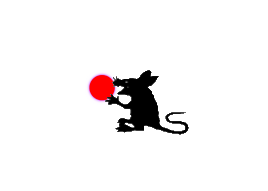Mad Like Artaud
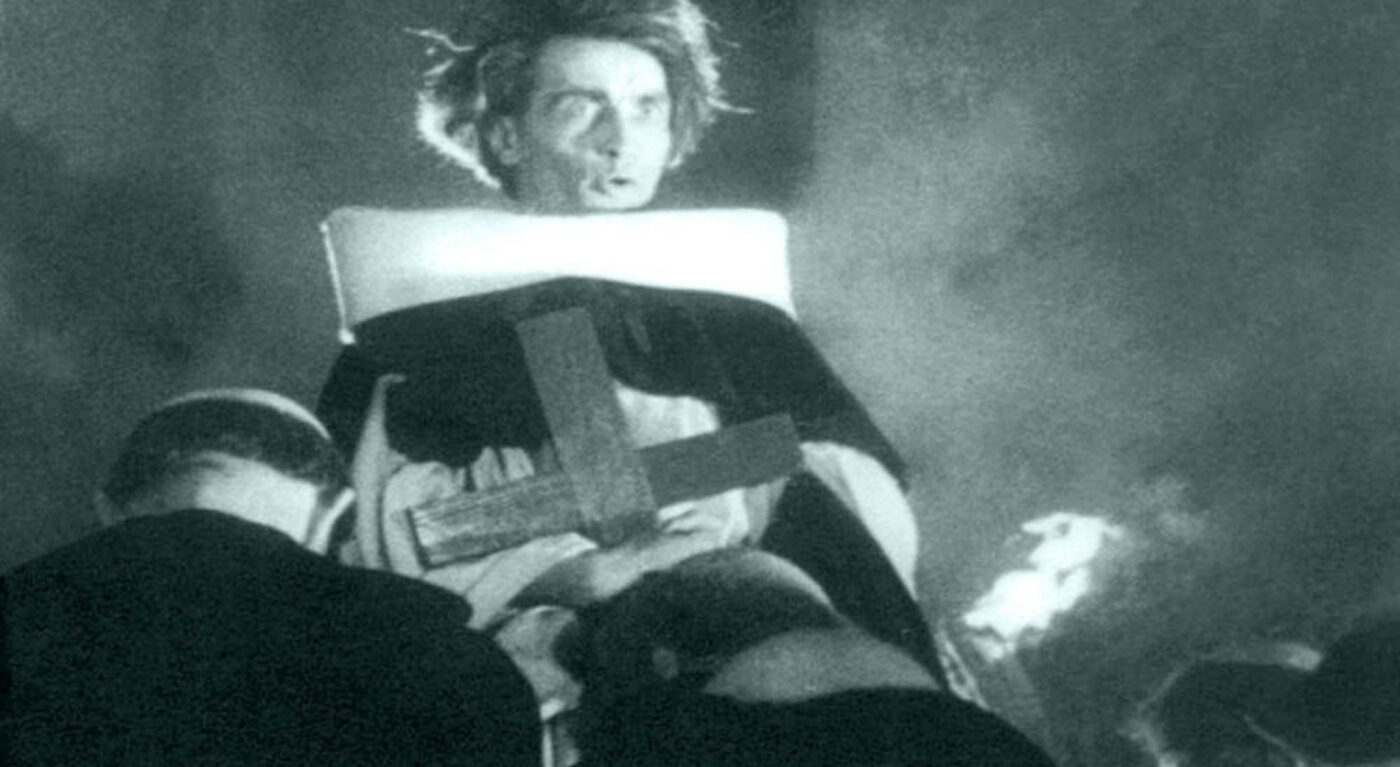
You selected the interview as one of your primary modes of writing early on, initially as a journalistic tool when you were writing for Paris Lettres, Les Lettres françaises, and L’Etrave in the 1960s. But eventually the interview became a way for you to work outside of existing academic protocols and expectations after you landed a job teaching at Columbia University in 1972. You’ve said in the past that you’re interested in the interview’s literary and dramatic possibilities; you’ve produced book-length interviews with thinkers like Paul Virilo and Jean Baudrillard, and your 1984 interview with Dr. Jacques Latrémolière, the assistant psychiatrist who administered shock therapy to Antonin Artaud at the asylum in Rodez, in the South of France, in the mid-1940s — that interview has been presented on the page, on the stage, on the radio, and for a while even The Berliner Ensemble wanted to perform it.
I’d like to return to this topic later, so we can talk about your decision to present your research in these different artistic mediums. But you’ve also described the interview as a process of disappearing and becoming something else, of becoming an artist or whomever it is you’re interviewing through them, by using their language to talk in a way that you couldn’t. This calls to mind Artaud, who through his work became Abelard and Uccello and Heliogabalus and Christ and Van Gough. “Leave your tongue, Paolo Uccello, leave your tongue, my tongue, my tongue, shit, who is speaking, where are you?” Or for Rimbaud: “Je est un autre” (I is someone else). In your way you became Artaud at different moments with your use of language and voice on the page, or when you had your head shaved on stage in the Poetry Project performance directed by Chris Kraus in 1985.
I want to ask you about your thoughts on the interview as a form with these different potentials, but I was also wondering if you could talk about this process of disappearing and becoming, not so much as a malady but as a method, since it characterizes the life/work of other philosopher/artists and fanatics who have played a key role in your thinking over the years (Bataille becomes Nietzsche, Simone Weil becomes a factory worker, a hunger artist, and so on).
Okay, so you push me a bit towards madness, right? I think I will take this literally. I was divided. On the one hand, and it depends what time of my life, but on the one hand I was actively doing things. On the other, I just wanted to disappear. It’s difficult for me to talk about it now, for I’m not in the same frame of mind. But at that time it felt as if everyday that I lived, I was glad that nothing had happened.
What age of yours are you thinking about?
I guess it’s mostly after I arrive in New York in 1972. These are effects, if you want, of what I had experienced as a child living through the war. Basically I felt like I wanted to keep a low profile. I could bring this back to Marcel Duchamp and The Blind Man (1917), to the process of disappearing as an artist. For him it was a method, and for me it became a method too. But it was a feeling that it was amazing that I was still alive another day. I’m already dead, I thought, so everyday that I live, I survive it. This gave me a lot of freedom, because if I disappeared it didn’t matter. It’s very difficult to explain. But I was kind of tormented in a sense. I wanted to leave no trace. To make interviews was a positive way of doing this.
I’d like to return to this topic later, so we can talk about your decision to present your research in these different artistic mediums. But you’ve also described the interview as a process of disappearing and becoming something else, of becoming an artist or whomever it is you’re interviewing through them, by using their language to talk in a way that you couldn’t. This calls to mind Artaud, who through his work became Abelard and Uccello and Heliogabalus and Christ and Van Gough. “Leave your tongue, Paolo Uccello, leave your tongue, my tongue, my tongue, shit, who is speaking, where are you?” Or for Rimbaud: “Je est un autre” (I is someone else). In your way you became Artaud at different moments with your use of language and voice on the page, or when you had your head shaved on stage in the Poetry Project performance directed by Chris Kraus in 1985.
I want to ask you about your thoughts on the interview as a form with these different potentials, but I was also wondering if you could talk about this process of disappearing and becoming, not so much as a malady but as a method, since it characterizes the life/work of other philosopher/artists and fanatics who have played a key role in your thinking over the years (Bataille becomes Nietzsche, Simone Weil becomes a factory worker, a hunger artist, and so on).
Okay, so you push me a bit towards madness, right? I think I will take this literally. I was divided. On the one hand, and it depends what time of my life, but on the one hand I was actively doing things. On the other, I just wanted to disappear. It’s difficult for me to talk about it now, for I’m not in the same frame of mind. But at that time it felt as if everyday that I lived, I was glad that nothing had happened.
What age of yours are you thinking about?
I guess it’s mostly after I arrive in New York in 1972. These are effects, if you want, of what I had experienced as a child living through the war. Basically I felt like I wanted to keep a low profile. I could bring this back to Marcel Duchamp and The Blind Man (1917), to the process of disappearing as an artist. For him it was a method, and for me it became a method too. But it was a feeling that it was amazing that I was still alive another day. I’m already dead, I thought, so everyday that I live, I survive it. This gave me a lot of freedom, because if I disappeared it didn’t matter. It’s very difficult to explain. But I was kind of tormented in a sense. I wanted to leave no trace. To make interviews was a positive way of doing this.
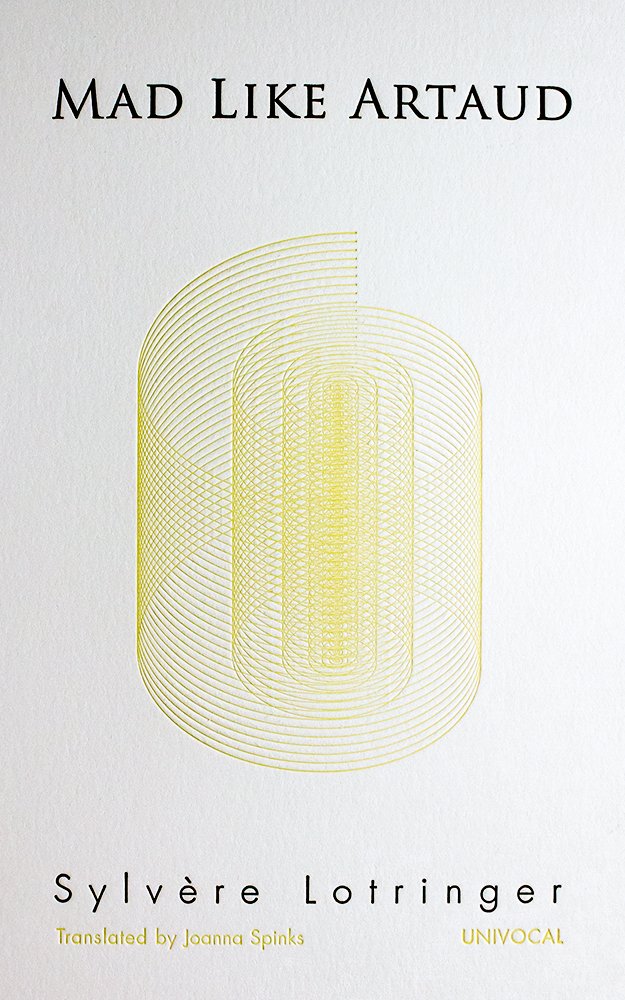
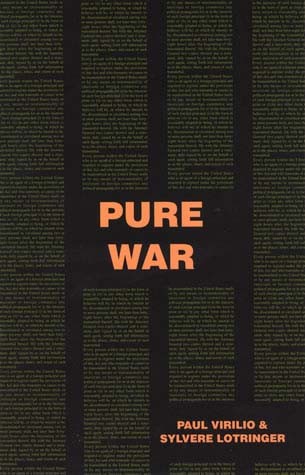

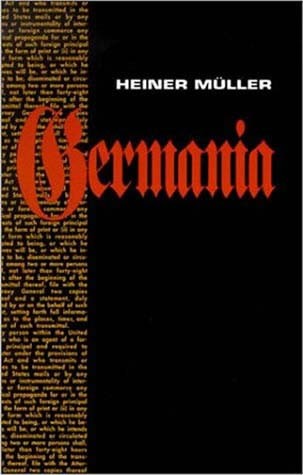
People will never know, as you know, how difficult it is to make interviews, how much you have to work on them. Latrémolière is an exception. It came exactly that way. But Ferdière [Dr. Gaston Ferdière, sometime poet and head psychiatrist at Rodez, who took in Artaud] was another story.
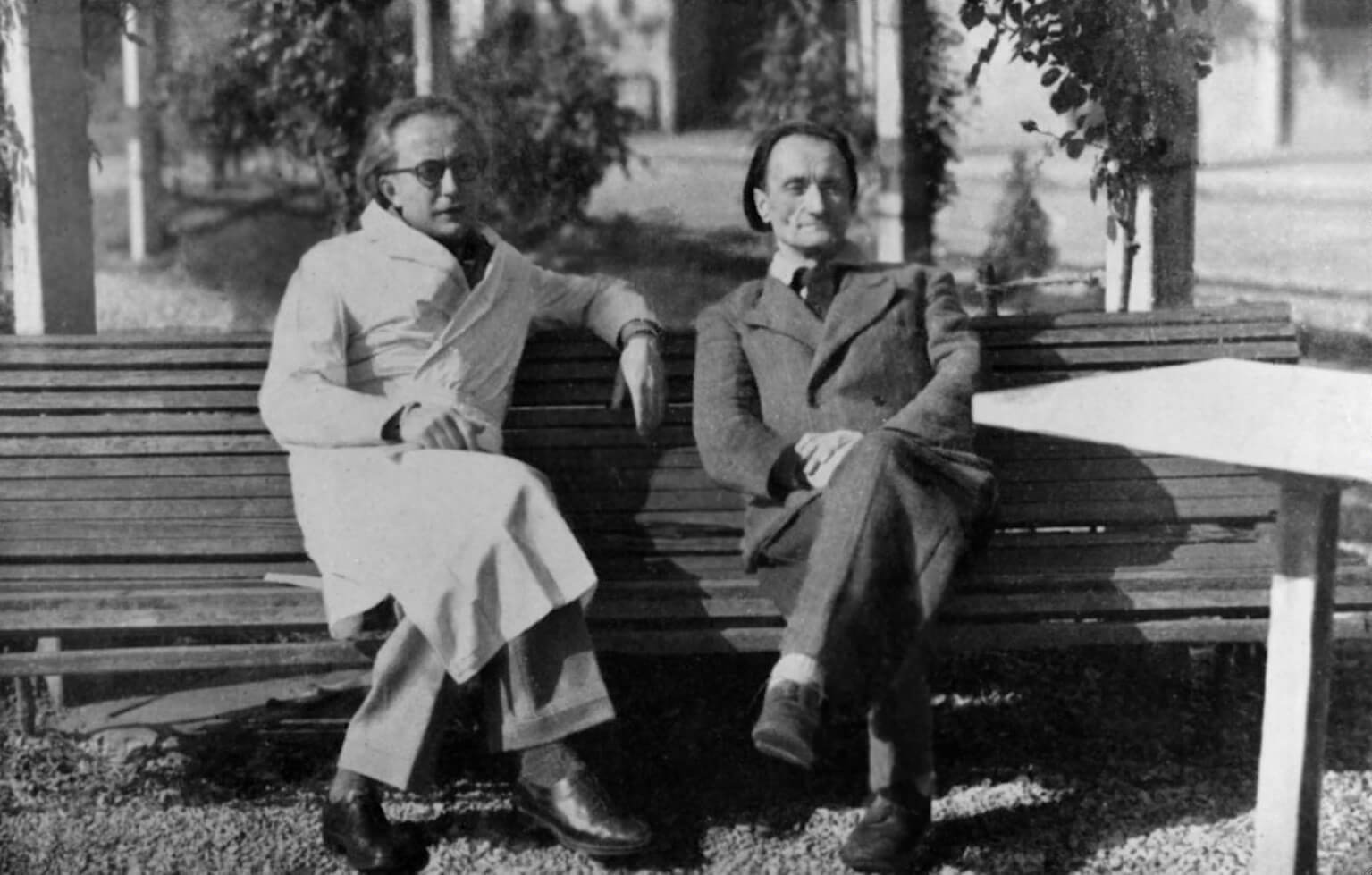
I had four or five hours of discussion on tape and from that I extracted what was really happening, what I didn’t see on the spot. So my relation to the interview comes from various directions. The simplest one is that, when you create a magazine, you have to get material. Interviewing people means you have access to some well-known people, people you’re interested in, and there are a number of benefits to that. First off, you have a piece to publish in the magazine. Secondly, you meet someone interesting and you learn something from them. And thirdly, no one knows how much work you put in it. So in a sense I enjoy the fact that people didn’t know how much I worked, because I didn’t present myself; I was secondary.
There is something attractive about being secondary or being invisible. But being invisible, yes, it meant that I could really relate to other people and bring them out in a way. Or maybe I brought out in them something I wasn’t quite capable of doing myself? Maybe I was playing against something that I’ve experienced but wasn’t totally in control of? It’s very difficult to figure out. On the one hand, I was very extroverted and all that. On the other, I wanted to be dead. That was it. And there was no conflict between the two. In a sense, it became a way of going from one to the other. I could become this, and I could become that. But the impulse originally wasn’t that. I guess I was just curious and I was interested to see all these people and excited to be able to exchange some views with them. To be a journalist became a way of amassing material. There was something else, too. The tape recorder was the only way you had to keep a record of anything. I mean I took pictures with a camera, but that wasn’t enough. The interview became a bit like time crystallized. I was fascinated by the fact, and I still am, that when I push play on the tape recorder I can feel someone exactly like it was at the time. Of course my voice is there, kind of lost. I’m there struggling with English, trying to ask questions. It’s like lost time. Time was going too fast, and I couldn’t retain anything of it. There was probably some anguish about it. I thought, I have to catch it, because this I will never see again.
We don’t usually pay attention to the present, but the present was going so fast. I didn’t want to slow it down but I thought the recordings of interviews could be like icebergs, things you could go to to recreate the space and everything that was happening there at the time, in your mind — and to recreate yourself, too. It was fascinating. The interview was my way of discovering things. That’s why I say to dramatize. This was before I read Artaud’s mental dramas. Interviews were like mental dramas because I wanted to come prepared, but in general terms. I wanted to be able to discover. And I wanted the interview to somehow be this developing thing so that you turn around and realize that something you talked about before suddenly had another entry. It’s like a perspectivist approach. I was trying to decipher what was going on and to discover it with another person, and then somehow to bring them to realize things that they may not have thought before. It was a process of discovery, and it’s exciting, as you know.
And then it’s extended. I remember going to Montreal with Chris Kraus, when we did some performances at a punk bar called Les Foufounes électrique. I had the idea of extending the interview as a form. I already did something like this with my friend in Germany: I made self-interviews.
I read something about “Confessions of a Ventriloquist,” a self-interview you performed in Montreal?
I wrote that for my German friends, as a forward to a book of interviews with artists in New York. In Montreal it was kind of fun. I took two tape recorders with me and I was asking questions and the tape recorders were asking questions to themselves and to me — it was like a dance. I was dramatizing myself through that.
Were there other performances that night?
There is something attractive about being secondary or being invisible. But being invisible, yes, it meant that I could really relate to other people and bring them out in a way. Or maybe I brought out in them something I wasn’t quite capable of doing myself? Maybe I was playing against something that I’ve experienced but wasn’t totally in control of? It’s very difficult to figure out. On the one hand, I was very extroverted and all that. On the other, I wanted to be dead. That was it. And there was no conflict between the two. In a sense, it became a way of going from one to the other. I could become this, and I could become that. But the impulse originally wasn’t that. I guess I was just curious and I was interested to see all these people and excited to be able to exchange some views with them. To be a journalist became a way of amassing material. There was something else, too. The tape recorder was the only way you had to keep a record of anything. I mean I took pictures with a camera, but that wasn’t enough. The interview became a bit like time crystallized. I was fascinated by the fact, and I still am, that when I push play on the tape recorder I can feel someone exactly like it was at the time. Of course my voice is there, kind of lost. I’m there struggling with English, trying to ask questions. It’s like lost time. Time was going too fast, and I couldn’t retain anything of it. There was probably some anguish about it. I thought, I have to catch it, because this I will never see again.
We don’t usually pay attention to the present, but the present was going so fast. I didn’t want to slow it down but I thought the recordings of interviews could be like icebergs, things you could go to to recreate the space and everything that was happening there at the time, in your mind — and to recreate yourself, too. It was fascinating. The interview was my way of discovering things. That’s why I say to dramatize. This was before I read Artaud’s mental dramas. Interviews were like mental dramas because I wanted to come prepared, but in general terms. I wanted to be able to discover. And I wanted the interview to somehow be this developing thing so that you turn around and realize that something you talked about before suddenly had another entry. It’s like a perspectivist approach. I was trying to decipher what was going on and to discover it with another person, and then somehow to bring them to realize things that they may not have thought before. It was a process of discovery, and it’s exciting, as you know.
And then it’s extended. I remember going to Montreal with Chris Kraus, when we did some performances at a punk bar called Les Foufounes électrique. I had the idea of extending the interview as a form. I already did something like this with my friend in Germany: I made self-interviews.
I read something about “Confessions of a Ventriloquist,” a self-interview you performed in Montreal?
I wrote that for my German friends, as a forward to a book of interviews with artists in New York. In Montreal it was kind of fun. I took two tape recorders with me and I was asking questions and the tape recorders were asking questions to themselves and to me — it was like a dance. I was dramatizing myself through that.
Were there other performances that night?
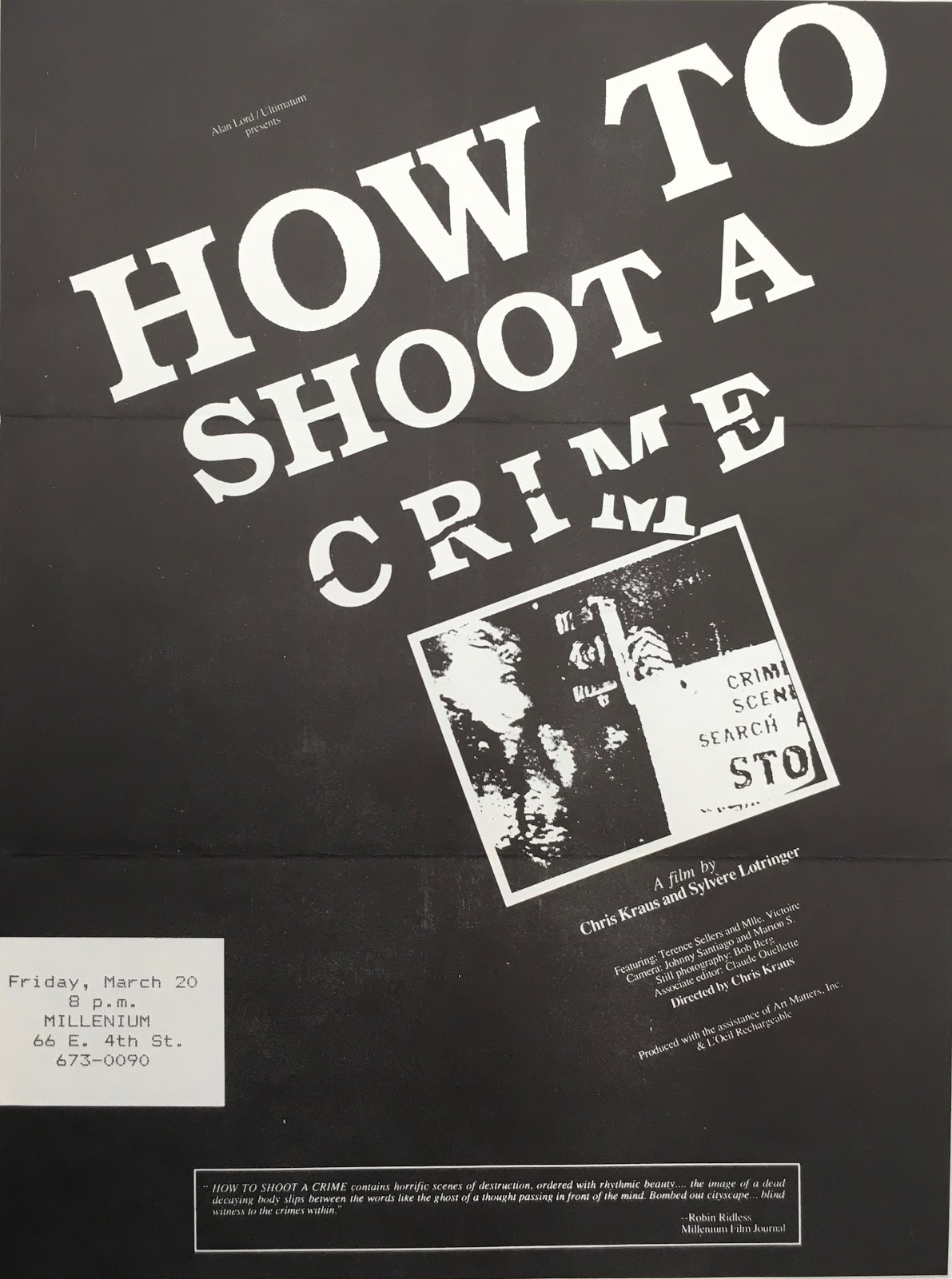
We showed How to Shoot a Crime (1987) for the first time, because we actually edited the film in Montreal. We didn’t have any money. But I thought it was kind of fun to extend, you know? I mean I had never performed in this way before. At that time to perform wasn’t much. But then I performed in Berlin, where again someone shaved my head, and made a drawing on my head. It was at the Winter Palace.
Was this another staging of I Talked About God with Antonin Artaud? Or Artaud Intime?
Yes, well that was first at the St. Mark’s Church. Chris Kraus was directing it. That’s how we met. She was directing that.
I Talked About God with Antonin Artaud at St. Mark’s Church, in 1985. That’s how you met Chris Kraus?
Was this another staging of I Talked About God with Antonin Artaud? Or Artaud Intime?
Yes, well that was first at the St. Mark’s Church. Chris Kraus was directing it. That’s how we met. She was directing that.
I Talked About God with Antonin Artaud at St. Mark’s Church, in 1985. That’s how you met Chris Kraus?
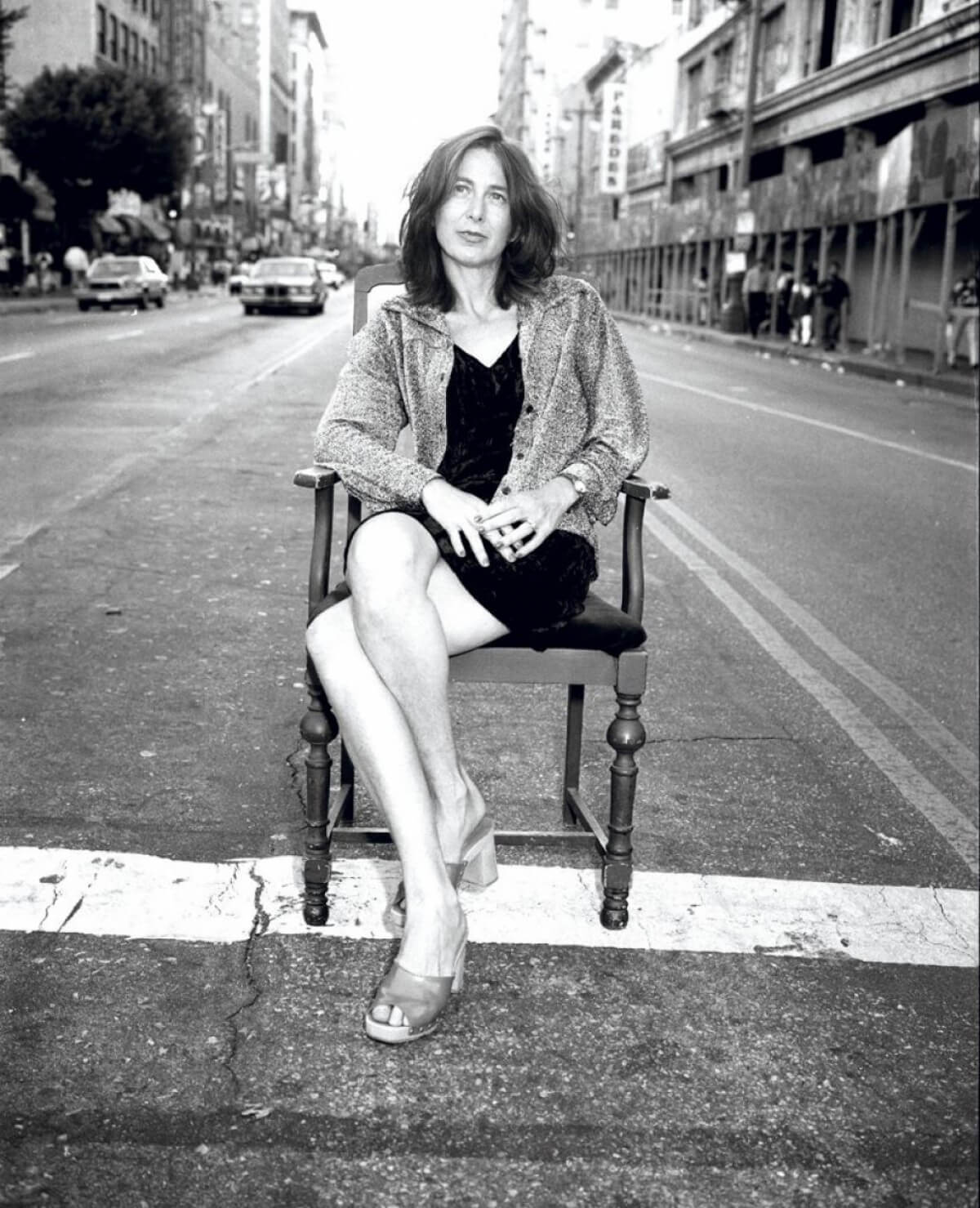
Well, yes, for the second time. I first met her in 1982-83 when she was a theater director. I mean it was very downtown. It was in whatever room was available and all that. She did something on Dada.
Readings From The Diaries of Hugo Ball?
Hugo Ball, yes. She sent out a few invitations. She hadn’t been in town for very long from New Zealand and she invited five people she wanted to meet and I was one of those. So I met her at the time. We dated briefly, and then— Is that how it happened? No, I think I went to a play, to Disparate Action / Desperate Action (1980), and that’s where I met her for the first time. And then I think we met again when there was a cocktail reception at the French Embassy. She also was invited for whatever reason, and I arrived for champagne wearing pilot’s overalls. Chris figured out that I wasn’t all together, and she was trying to establish a contact. Then she said, maybe I have a chance? I didn’t know that at the time, but I was kind of, you know, smoking lots of dope and doing lots of things. I couldn’t care less about the way I was dressing or what I was doing. It was a free time.
But to come back to the question of the interview, when I arrived in New York and started doing things, the interview was already a tool I had. That was the only tool. It’s transportable, and you can create a multiplicity of things with it. And it was some sort of writing that you can do without getting spotted or rewarded for it. There was always a feeling I had that I didn’t completely want to come out, you know? I was pretty much pleased to remain invisible. At the same time, I was doing things that were making me visible. I couldn’t avoid it in a way. It was very difficult and complicated in my mind.
This is going to bring us back to Artaud, but I’m wondering if you attended the 1972 Artaud/Bataille colloquium at Cerisy, which was organized by Philippe Sollers and Tel Quel?
Readings From The Diaries of Hugo Ball?
Hugo Ball, yes. She sent out a few invitations. She hadn’t been in town for very long from New Zealand and she invited five people she wanted to meet and I was one of those. So I met her at the time. We dated briefly, and then— Is that how it happened? No, I think I went to a play, to Disparate Action / Desperate Action (1980), and that’s where I met her for the first time. And then I think we met again when there was a cocktail reception at the French Embassy. She also was invited for whatever reason, and I arrived for champagne wearing pilot’s overalls. Chris figured out that I wasn’t all together, and she was trying to establish a contact. Then she said, maybe I have a chance? I didn’t know that at the time, but I was kind of, you know, smoking lots of dope and doing lots of things. I couldn’t care less about the way I was dressing or what I was doing. It was a free time.
But to come back to the question of the interview, when I arrived in New York and started doing things, the interview was already a tool I had. That was the only tool. It’s transportable, and you can create a multiplicity of things with it. And it was some sort of writing that you can do without getting spotted or rewarded for it. There was always a feeling I had that I didn’t completely want to come out, you know? I was pretty much pleased to remain invisible. At the same time, I was doing things that were making me visible. I couldn’t avoid it in a way. It was very difficult and complicated in my mind.
This is going to bring us back to Artaud, but I’m wondering if you attended the 1972 Artaud/Bataille colloquium at Cerisy, which was organized by Philippe Sollers and Tel Quel?
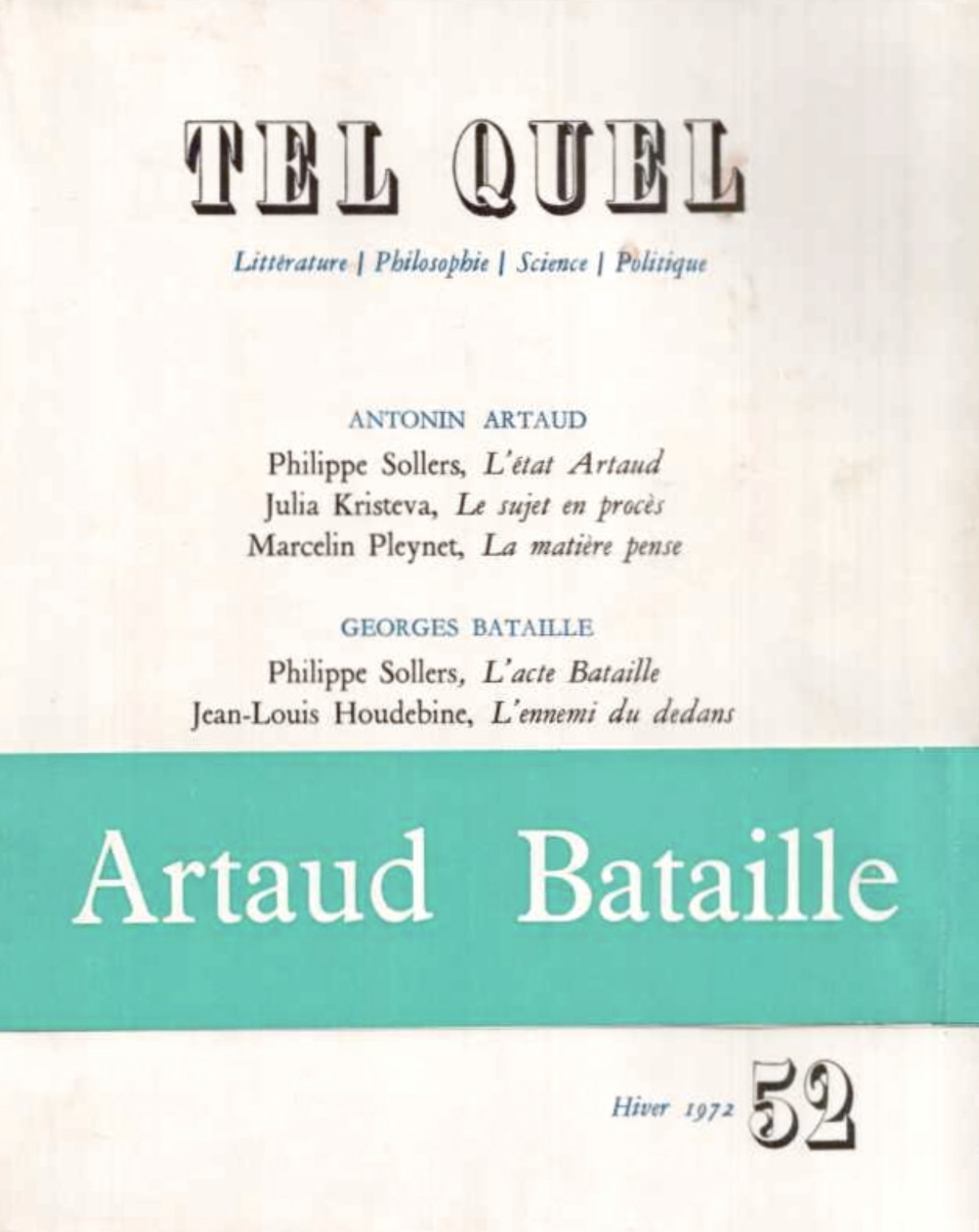
Yes, because in 1969 I came back from Australia and I got a job at Swarthmore. The job collapsed with the rebellion on campus, at the time of the Kent State killing. After that they shut off the academy. No more money for the university. I was then catapulted to Cleveland, to Case Western Reserve. They asked me, or I suggested, to take students to France for the summer. It was a way of going to France and also catching up with what had happened to France when I was in Turkey. Things had moved; it wasn’t the New Critique any more, it was Semiotics, etc. I had some entry when I took classes with Barthes, but there were other figures I didn’t know. There was Genette, there was Lacan, there was Bataille, and there was also Artaud.
So yes, I attended because I took students from Case Western Reserve to Cerisy as part of a program I arranged, to attend this colloquium. At the same time I have to say that it was a very elitist little place in a castle in Normandy, and all the New Novelists kept coming, or all the Tel Quel group was coming, etc. etc. So at the same time, I happened to meet a lot of people at Cerisy. Some of them I already knew. I knew Kristeva from Lucien Goldmann’s class, and the people from Tel Quel I had already met before. I had read the first issue of Tel Quel when I was living in Edinburgh, and I was in touch with some of them at the time. I was already introduced, but I wanted to go to Cerisy to catch up and to see what’s happening.
So yes, I attended because I took students from Case Western Reserve to Cerisy as part of a program I arranged, to attend this colloquium. At the same time I have to say that it was a very elitist little place in a castle in Normandy, and all the New Novelists kept coming, or all the Tel Quel group was coming, etc. etc. So at the same time, I happened to meet a lot of people at Cerisy. Some of them I already knew. I knew Kristeva from Lucien Goldmann’s class, and the people from Tel Quel I had already met before. I had read the first issue of Tel Quel when I was living in Edinburgh, and I was in touch with some of them at the time. I was already introduced, but I wanted to go to Cerisy to catch up and to see what’s happening.


It was an interesting colloquium in many ways, first of all because I really discovered Artaud there, from Kristeva and Sollers. There were all these games going on, and the people who were gathered were a very fashionable group doing in France what I would do later in the States, introducing a lot of things at the same time that don’t always go together. And there was also Denis Hollier who I met at Cerisy. He was a Bataille specialist. We became great friends and I invited him to teach at one of my summer schools. The first one was in Nevers, I think, like the town in Marguerite Duras’s Hiroshima, mon amour. The second summer school was Vichy — another reference. But each time I was taking the students to this chateau at Cerisy.
So Denis Hollier came and taught Bataille and Artaud. Catherine Clément, who was both a specialist of Levi-Strauss and Lacan, was giving another class that summer. And another friend who I knew as an anthropologist was giving a class on Levi-Strauss. I didn’t know much about Levi-Strauss at the time, and I didn’t know much about Bataille. So it was like I was retraining myself. I was already living in the States, which means I was not part of the day-to-day intellectual life in France. So I created this for myself in small ways. That’s what I would do later when Columbia hired me [also in 1972] at Reed Hall, by Montparnasse. I invited Félix Guattari, I invited Catherine Clément, I invited Serge Leclair, a Lacanian psychoanalyst. It was a mixed group of people and I took their classes, especially Félix’s. He became a very good friend. And the idea kept on. So I said to him, okay, why don’t you come to the States? He was all up for it, so that’s how it started.
So Denis Hollier came and taught Bataille and Artaud. Catherine Clément, who was both a specialist of Levi-Strauss and Lacan, was giving another class that summer. And another friend who I knew as an anthropologist was giving a class on Levi-Strauss. I didn’t know much about Levi-Strauss at the time, and I didn’t know much about Bataille. So it was like I was retraining myself. I was already living in the States, which means I was not part of the day-to-day intellectual life in France. So I created this for myself in small ways. That’s what I would do later when Columbia hired me [also in 1972] at Reed Hall, by Montparnasse. I invited Félix Guattari, I invited Catherine Clément, I invited Serge Leclair, a Lacanian psychoanalyst. It was a mixed group of people and I took their classes, especially Félix’s. He became a very good friend. And the idea kept on. So I said to him, okay, why don’t you come to the States? He was all up for it, so that’s how it started.

I asked about the 1972 Cerisy colloquium to raise a question about Artaud’s reception. There are many Artauds, and people make of him what they will. But what’s interesting in this case is that the colloquium was framed in what would then be associated with the Maoist language of revolt — because it was titled “Vers une Révolution Culturelle: Artaud, Bataille.” And yet in 1927, in a piece titled “In Total Darkness, or The Surrealist Bluff,” Artaud makes it clear that his fallout with Breton and the Surrealists had everything to do with their decision to align with the French Communist Party by embracing a program for revolution that Artaud claimed was at odds with the spirit of the Surrealist adventure. “The whole root, all the exacerbations of our quarrel,” he explains, “turn on the word ‘Revolution.’” Likewise, when he goes to Mexico City in 1936, a year after his supposed reconciliation with Breton, he reiterates his discord and again denounces “the revolution invented by Marx” as “a caricature of life.”
On the other hand, Artaud was fascinated by the communism he says he found existing in a feeling of spontaneous solidarity among the Tarahumara Indians, who also gave him an experience with the cruelty he sought. He went on to write about his experience with the Tarahumara Indians for twelve years, throughout his stay at Rodez, until his death at Ivry in 1948. So I’m curious about the framing of Artaud in the context of that important colloquium, which was partly about Tel Quel shifting the discourse around the legacy of Surrealism in the postwar period and partly about a splitting within the 20th century Marxist tradition.
I didn’t know so much about Maoism. The Mao thing was in the early 70s and actually I missed most of it. And I have to say that I didn’t pay attention to it because I thought it was too much. The Tel Quel people were in the Communist Party and under some feeble excuses they dropped out of the Communist Party mutely, and so I thought, enough. But you’re right, at the time they were Maoists.
Kristeva gave this article on Artaud which is actually probably the best thing she wrote and was the nucleus of work she put together later. It was psychoanalytical. It was all about the fact that Artaud hadn’t really passed the abject exam; the first phase, the fecal phase, he didn’t absorb it and was repulsed by it and was constantly reiterating the cut. All this was new terminology. It had nothing Maoist about it, and her talk was very well-received. Philippe Sollers gave a paper after that that was a bit of a mimic of Artaud, only it wasn’t very well received, so he spent the whole night raiding the girls’ dorm to compensate for it.
The idea of having a French Mao was stupid. I never took them seriously, like when Sollers organized travel to China. How imitative of you of the Surrealists, I thought. It was an abomination. Lacan promised he would go but he didn’t. Roland Barthes was depressed there, because of the gay situation in China. The only one who was comfortable was Kristeva, who was writing about how great it was to restrain the Chinese feet. For me they lost all credibility, not culturally, but politically, at the time. So I didn’t pay attention to what was going on.
On the other hand there were people like Bernard Henri-Lévy inviting workers to his apartment to talk about rebellion in the factory. There were a few people who were emotionally connected to that, because it had to do with workers and people who were being oppressed. This I respected. But the rest, this was the worst aspect of French intellectualism, which was going in neutral. May 68 was an attempt to change things. But this salon reiteration of the Surrealist movement didn’t appeal to me at all.
So no, I think the revolution was over. I think my relation to Artaud maybe took off a bit at this colloquium, but it went immediately somewhere else for me. First of all you can’t avoid identifying with Artaud, identifying with his wounds. Artaud is a kind of trap, a black hole. There is no doubt that I started teaching Artaud and becoming half-crazed because I couldn’t teach Artaud in my right frame of mind, so I was taking drugs before class; I had to be in a certain sensibility to do it. That helped. I was trying lots of drugs at the time. I never knew what drugs were before I arrived in New York. Artaud was part of that, the violence of it or the rejection of so many things. I was trying at that time to remain at Columbia without being part of Columbia; I was defining my attitude in relation to it, seeing how far I could go. I was very tempted to be fired, but at the same time I wasn’t crazy enough to be fired from Columbia, because Columbia had some sort of attraction, not for me but for people outside. It made it very easy for me to meet artists and all that. I felt like the only academic in the States to be interested in this sort of thing, of going into the art world.
Artaud was part of what I discovered at that time. I was teaching Surrealism and Dada. Surrealism I didn’t like so much; Dada, yes. Artistically the Surrealists weren’t interesting, except maybe Dali. I like Dali’s delirium and his writing on delirium. I’ve always been fascinated by the idea of delirium. Some of my living in New York at that time was fairly delirious, not in a schizophrenic way, but there were no limits. You can go anywhere you want and take any risk that you can. Just don’t think about tomorrow. That was part of my thinking also: that everyday’s the end of it. I didn’t want to see the consequences. I was ready for anything and Artaud came in that context. Artaud was sounding something that affected me. In a way I understood his refusal of Marxism; I understood how painful it must have been to be Artaud.
On the other hand, Artaud was fascinated by the communism he says he found existing in a feeling of spontaneous solidarity among the Tarahumara Indians, who also gave him an experience with the cruelty he sought. He went on to write about his experience with the Tarahumara Indians for twelve years, throughout his stay at Rodez, until his death at Ivry in 1948. So I’m curious about the framing of Artaud in the context of that important colloquium, which was partly about Tel Quel shifting the discourse around the legacy of Surrealism in the postwar period and partly about a splitting within the 20th century Marxist tradition.
I didn’t know so much about Maoism. The Mao thing was in the early 70s and actually I missed most of it. And I have to say that I didn’t pay attention to it because I thought it was too much. The Tel Quel people were in the Communist Party and under some feeble excuses they dropped out of the Communist Party mutely, and so I thought, enough. But you’re right, at the time they were Maoists.
Kristeva gave this article on Artaud which is actually probably the best thing she wrote and was the nucleus of work she put together later. It was psychoanalytical. It was all about the fact that Artaud hadn’t really passed the abject exam; the first phase, the fecal phase, he didn’t absorb it and was repulsed by it and was constantly reiterating the cut. All this was new terminology. It had nothing Maoist about it, and her talk was very well-received. Philippe Sollers gave a paper after that that was a bit of a mimic of Artaud, only it wasn’t very well received, so he spent the whole night raiding the girls’ dorm to compensate for it.
The idea of having a French Mao was stupid. I never took them seriously, like when Sollers organized travel to China. How imitative of you of the Surrealists, I thought. It was an abomination. Lacan promised he would go but he didn’t. Roland Barthes was depressed there, because of the gay situation in China. The only one who was comfortable was Kristeva, who was writing about how great it was to restrain the Chinese feet. For me they lost all credibility, not culturally, but politically, at the time. So I didn’t pay attention to what was going on.
On the other hand there were people like Bernard Henri-Lévy inviting workers to his apartment to talk about rebellion in the factory. There were a few people who were emotionally connected to that, because it had to do with workers and people who were being oppressed. This I respected. But the rest, this was the worst aspect of French intellectualism, which was going in neutral. May 68 was an attempt to change things. But this salon reiteration of the Surrealist movement didn’t appeal to me at all.
So no, I think the revolution was over. I think my relation to Artaud maybe took off a bit at this colloquium, but it went immediately somewhere else for me. First of all you can’t avoid identifying with Artaud, identifying with his wounds. Artaud is a kind of trap, a black hole. There is no doubt that I started teaching Artaud and becoming half-crazed because I couldn’t teach Artaud in my right frame of mind, so I was taking drugs before class; I had to be in a certain sensibility to do it. That helped. I was trying lots of drugs at the time. I never knew what drugs were before I arrived in New York. Artaud was part of that, the violence of it or the rejection of so many things. I was trying at that time to remain at Columbia without being part of Columbia; I was defining my attitude in relation to it, seeing how far I could go. I was very tempted to be fired, but at the same time I wasn’t crazy enough to be fired from Columbia, because Columbia had some sort of attraction, not for me but for people outside. It made it very easy for me to meet artists and all that. I felt like the only academic in the States to be interested in this sort of thing, of going into the art world.
Artaud was part of what I discovered at that time. I was teaching Surrealism and Dada. Surrealism I didn’t like so much; Dada, yes. Artistically the Surrealists weren’t interesting, except maybe Dali. I like Dali’s delirium and his writing on delirium. I’ve always been fascinated by the idea of delirium. Some of my living in New York at that time was fairly delirious, not in a schizophrenic way, but there were no limits. You can go anywhere you want and take any risk that you can. Just don’t think about tomorrow. That was part of my thinking also: that everyday’s the end of it. I didn’t want to see the consequences. I was ready for anything and Artaud came in that context. Artaud was sounding something that affected me. In a way I understood his refusal of Marxism; I understood how painful it must have been to be Artaud.
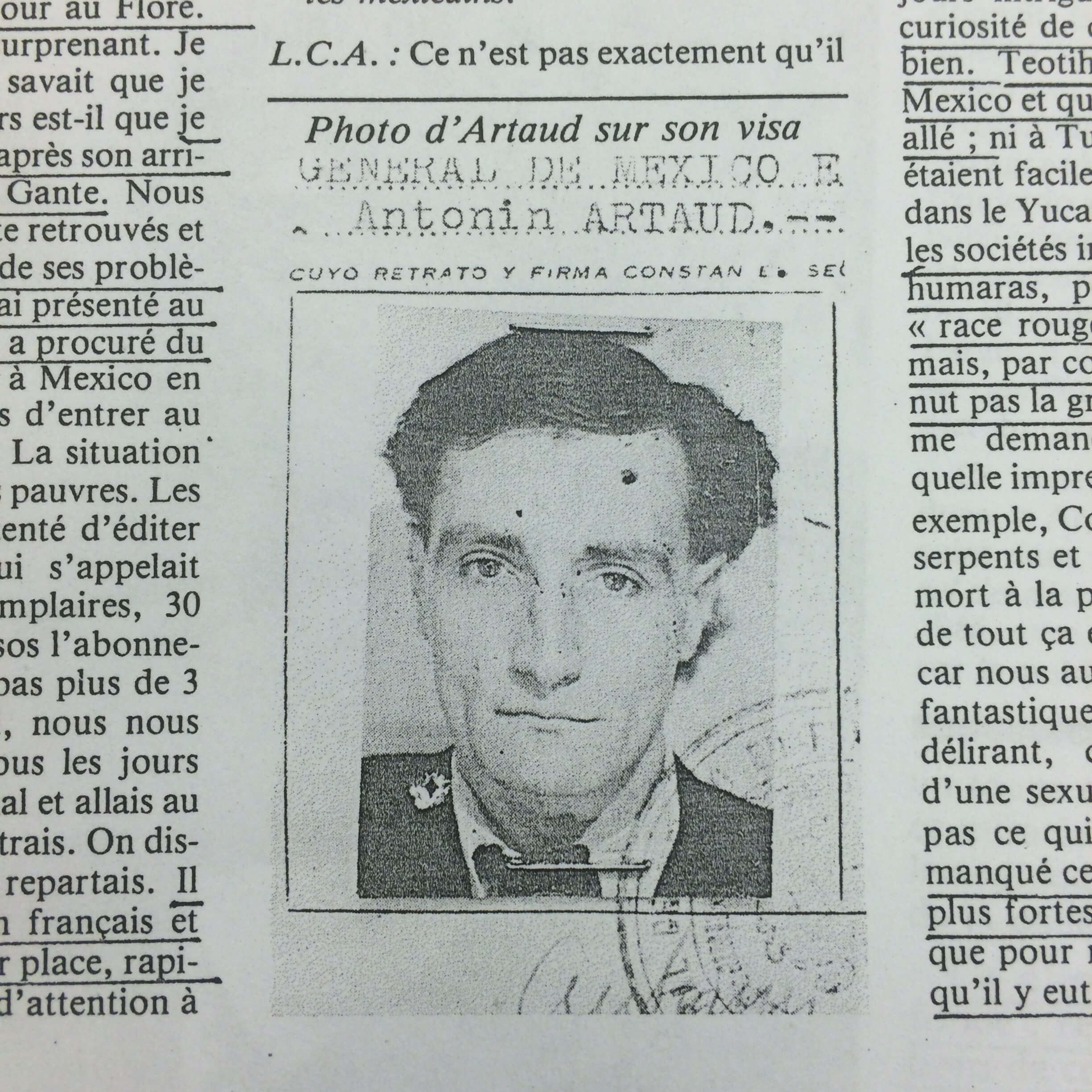
In 1937 Artaud travelled to the Aran Islands in the west of Ireland to return what he said was the staff of St. Patrick to its rightful owners, and to search for descendents of the Druids. Broke and delirious, he suffered a severe mental breakdown, was arrested, and was then deported. Prior to this trip he was reading the early Christians, the Kabbalah, The Egyptian Book of the Dead, and studying Assyrian incantations. The year before he had gone to Mexico to search for healers and sorcerers and traces of Pre-Columbian civilization.
Meanwhile in Paris Georges Bataille, Roger Callois, and others were forming the “Collège de sociologie.” Like Artaud, they too were interested in myths, rituals, and the role of the sacred in contemporary society. They pursued what they called a sacred sociology, and as with Artaud, there was a violence that permeated their imagination. I wonder what you think about these “sacred” and violent intellectual projects in relation to what was then burgeoning as fascism, because by this time, at the end of the 1930s, the battle was both dangerous and on the move.
Meanwhile in Paris Georges Bataille, Roger Callois, and others were forming the “Collège de sociologie.” Like Artaud, they too were interested in myths, rituals, and the role of the sacred in contemporary society. They pursued what they called a sacred sociology, and as with Artaud, there was a violence that permeated their imagination. I wonder what you think about these “sacred” and violent intellectual projects in relation to what was then burgeoning as fascism, because by this time, at the end of the 1930s, the battle was both dangerous and on the move.


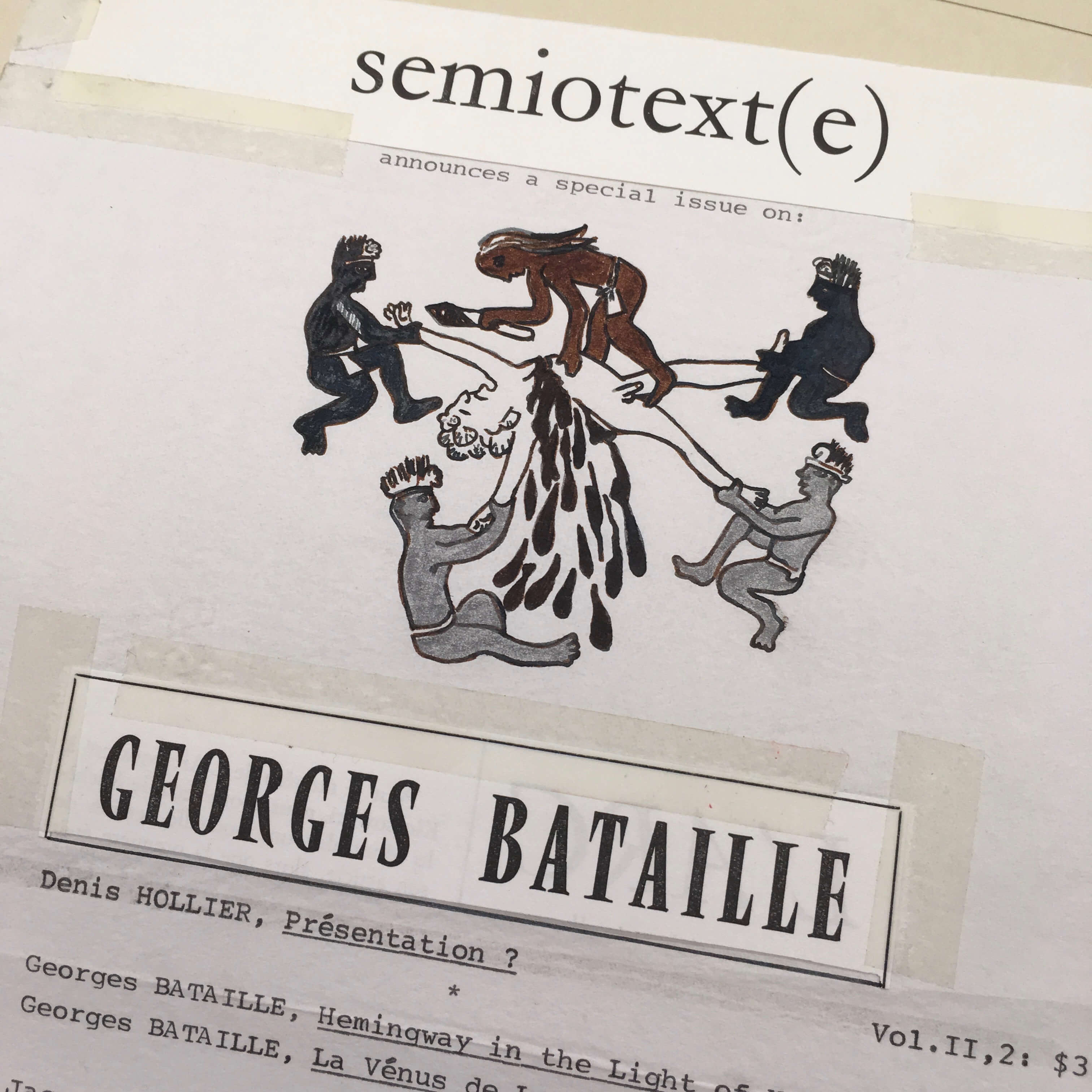
It’s a paradoxical involvement. I couldn’t get directly to this violence and this kind of affect and emotion. I worked out a detour. For me, Artaud was Artaud and his problems were his problems. I didn’t want to identify with them. I wanted to use him as a key to open this realm of violence, of sacrifice, etc., but I didn’t want it for myself. I wanted to understand where it was coming from, and I took them more as a ride. They were my Christian extremists — they were going to the extreme. Luckily I didn’t go to the extreme, but they opened that door. I was protected against it at the same time because I’m no Christian and I’m not an extremist in that way. They gave me the possibility of getting close to things that affected me, but with a distance, in that I’m not them. I don’t have to go all the way back to the primitive in order to strengthen the religion that was failing at the time. But they had their own purposes and I had other purposes. All of them were breaking away from the church by becoming more Christian than the Christians. That’s where the source of their violence was. They wanted to reclaim, between the two world wars, when France stopped being an agricultural country and people moved to the cities. France was not a full-fledged industrial country at the time; it was 80 percent agricultural. When peasants moved to the city, they were not harnessed by the priest, by the church, by the family. They were loose. So religion lost a lot of its authority when the masses moved to the cities. Artaud and Bataille were part of that movement away from the territorial grounding of the church. What they preserved was the necessity of the grounding, literally. In other words they went to the pagans, they derived a cosmic sense of life.
Maybe it’s mixed up, like I was identifying with what their purpose was. Their purpose was not my purpose. It was like going to the war with a screen. Emotionally, I was not ready to accept them directly; it was too emotional. I closed off a whole year of my life and they were the means by which I had access to what had affected me most. And I didn’t have to involve myself in it personally. I just turned that into an analysis of France at the time, what was happening in France, the occupation, the extermination. It was just too much for me to deal with directly. So they were my messengers. They were my yellow canaries. They allowed me to do a lot of emotional work that I wouldn’t be able to do. I never wanted to go into psychoanalysis, and for good reason. I thought that what I experienced and what made me so traumatized in a way had nothing to do with me. It didn’t belong to me. I wanted to plumb where it was coming from and how everything had happened. But my interest in these figures is also an interest in people who forged concepts that were capable of matching these events, and the events were not the same. But through the pain that they had, I found something of the pain that I couldn’t express. Artaud and Bataille were the least I could hold onto to learn something of the situation.
They offered what Ernst Bloch would call an anticipatory illumination, or maybe a perversion of it from the dark side.
Yeah, but their sacrifices were not exactly what I was interested in, because theirs were very calculated, very controlled. But it was a ritual. There was a group of men who were there and they develop a bond because they were confronted with death. Some element of that interested me. I took it more as an attempt to create some sort of an organic bond in a world where this bond had dissipated in such a way that, yes, it degenerated into fascism and fanaticism, the masses running into each other, the whole distraction.
For me, Artaud and Bataille, Simone Weil, you know, all the emotional tribe, they had anticipated what was going to happen and they tried to forge little cells where a vaccine was being invented, a bit like the plague. It was a counter-plague, but if they managed to be contaminated in a ritualistic way, then it could go viral and counter the whole wave of massacres and violence that was going over the world. So I think they were creating little laboratories, using whatever was at hand. Artaud and Bataille were both Christian, and they thought of becoming priests, just like Hitler and Stalin. They were all in cahoots for this Christianity, attempting to compensate with a Christianity that might go beyond it. So I followed suit. I went on my horse and said, okay, just show me the way. I can go there and take what I need and face the unfaceable. I needed to have people who had their own itinerary that led them in the same direction, but I couldn’t take it. It was too much for me.
The disappearing we were discussing, was that a concern for you in the making of Second Hand Hitler (1985), the film you shot in West Germany? In that film the character Gunther is auditioning to play Artaud and gets confused with Hitler, has a seizure, and becomes Hitler. “I am not an actor,” he says, “I am Hitler.”
It was complicated. First of all, there’s an element of that film that I don’t like. I was arriving in Berlin and I was positioned upon my arrival as a New York filmmaker, which I was not, so I was not exactly in my water. And emotionally, I just wasn’t there. I didn’t know what to do about Hitler. I thought making a film would help me approach him. I guess in some way I never read so much about Hitler. I couldn’t approach him and I didn’t know what to do with him. There’s a second version of the film where I say, look, I do something with Hitler but the thing that bothers me most is that I don’t feel anything in relation to him, and I was panicked by this at the start: that I don’t feel hatred, that I don’t feel like this is a monster. For me it was just a blank. I was expecting to be really involved emotionally in the film, and I was not. That was the discovery of the film.
Artaud claims he met Hitler in a cafe in 1932 and retroactively dedicated The New Revelations of Being (1937) to him in 1943.
We can’t always believe Artaud.
But about this film, were you friends with the writer Walter Abish at the time?
Yeah.
Because he had written a novel called How German Is It just a few years before you made this film, and since you were friends I wonder if you were possibly responding to his book, or to the problem of living in a “new democracy” while failing to address a violent past that still haunted the process of redefinition after the war?
Maybe it’s mixed up, like I was identifying with what their purpose was. Their purpose was not my purpose. It was like going to the war with a screen. Emotionally, I was not ready to accept them directly; it was too emotional. I closed off a whole year of my life and they were the means by which I had access to what had affected me most. And I didn’t have to involve myself in it personally. I just turned that into an analysis of France at the time, what was happening in France, the occupation, the extermination. It was just too much for me to deal with directly. So they were my messengers. They were my yellow canaries. They allowed me to do a lot of emotional work that I wouldn’t be able to do. I never wanted to go into psychoanalysis, and for good reason. I thought that what I experienced and what made me so traumatized in a way had nothing to do with me. It didn’t belong to me. I wanted to plumb where it was coming from and how everything had happened. But my interest in these figures is also an interest in people who forged concepts that were capable of matching these events, and the events were not the same. But through the pain that they had, I found something of the pain that I couldn’t express. Artaud and Bataille were the least I could hold onto to learn something of the situation.
They offered what Ernst Bloch would call an anticipatory illumination, or maybe a perversion of it from the dark side.
Yeah, but their sacrifices were not exactly what I was interested in, because theirs were very calculated, very controlled. But it was a ritual. There was a group of men who were there and they develop a bond because they were confronted with death. Some element of that interested me. I took it more as an attempt to create some sort of an organic bond in a world where this bond had dissipated in such a way that, yes, it degenerated into fascism and fanaticism, the masses running into each other, the whole distraction.
For me, Artaud and Bataille, Simone Weil, you know, all the emotional tribe, they had anticipated what was going to happen and they tried to forge little cells where a vaccine was being invented, a bit like the plague. It was a counter-plague, but if they managed to be contaminated in a ritualistic way, then it could go viral and counter the whole wave of massacres and violence that was going over the world. So I think they were creating little laboratories, using whatever was at hand. Artaud and Bataille were both Christian, and they thought of becoming priests, just like Hitler and Stalin. They were all in cahoots for this Christianity, attempting to compensate with a Christianity that might go beyond it. So I followed suit. I went on my horse and said, okay, just show me the way. I can go there and take what I need and face the unfaceable. I needed to have people who had their own itinerary that led them in the same direction, but I couldn’t take it. It was too much for me.
The disappearing we were discussing, was that a concern for you in the making of Second Hand Hitler (1985), the film you shot in West Germany? In that film the character Gunther is auditioning to play Artaud and gets confused with Hitler, has a seizure, and becomes Hitler. “I am not an actor,” he says, “I am Hitler.”
It was complicated. First of all, there’s an element of that film that I don’t like. I was arriving in Berlin and I was positioned upon my arrival as a New York filmmaker, which I was not, so I was not exactly in my water. And emotionally, I just wasn’t there. I didn’t know what to do about Hitler. I thought making a film would help me approach him. I guess in some way I never read so much about Hitler. I couldn’t approach him and I didn’t know what to do with him. There’s a second version of the film where I say, look, I do something with Hitler but the thing that bothers me most is that I don’t feel anything in relation to him, and I was panicked by this at the start: that I don’t feel hatred, that I don’t feel like this is a monster. For me it was just a blank. I was expecting to be really involved emotionally in the film, and I was not. That was the discovery of the film.
Artaud claims he met Hitler in a cafe in 1932 and retroactively dedicated The New Revelations of Being (1937) to him in 1943.
We can’t always believe Artaud.
But about this film, were you friends with the writer Walter Abish at the time?
Yeah.
Because he had written a novel called How German Is It just a few years before you made this film, and since you were friends I wonder if you were possibly responding to his book, or to the problem of living in a “new democracy” while failing to address a violent past that still haunted the process of redefinition after the war?

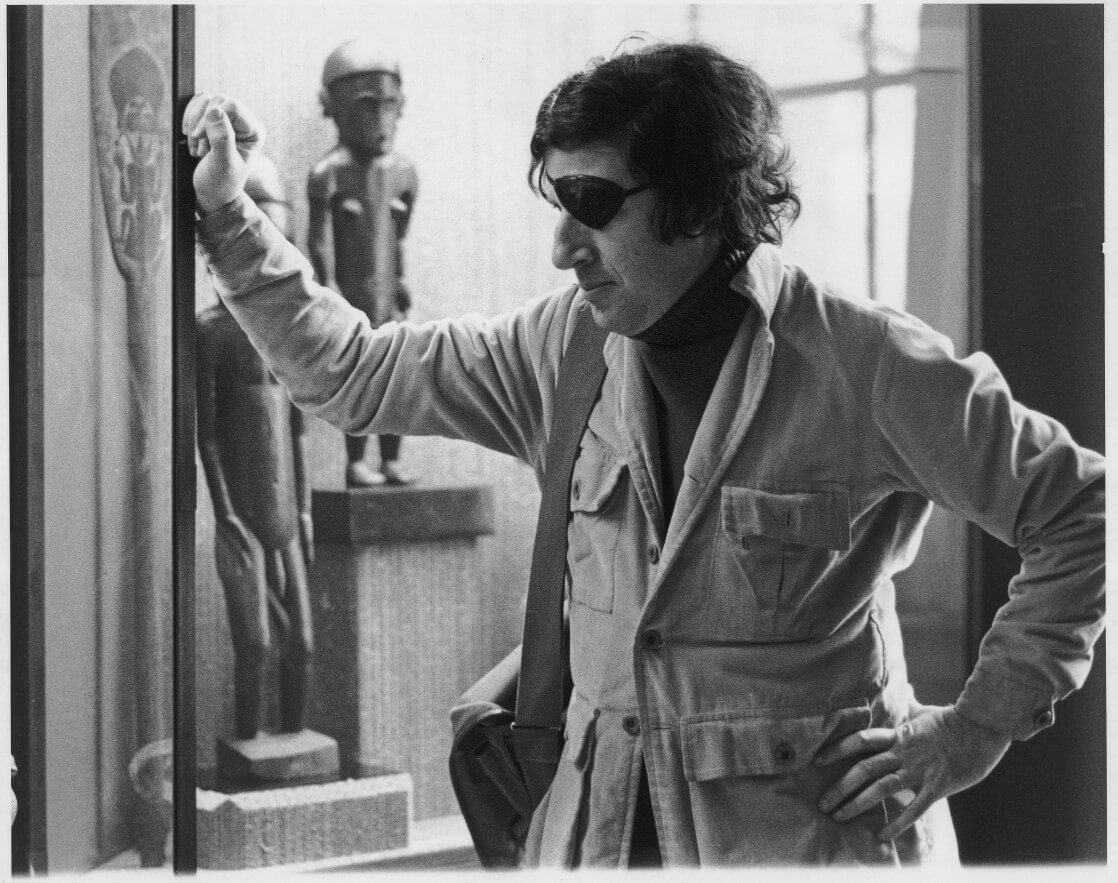
Yeah, but once again it was their problem. I didn’t want it to be mine, you see? I went to Germany with a group of people — Chris Kraus, Kathy Acker, Eileen Myles, Richard Hell, Lynne Tillman, and Anne Rower — and when I was there an elderly German came to me and said, you know, I was not part of that. Or, I was part of the resistance. But that was their problem. On the other hand, I felt very close to the new generation of Germans, much closer than I would with the French people. The French people always made me feel like a foreigner, starting with my name. They made me feel like there was something that was not right. In France you always felt like you were one step from being ostracized, and it’s still the same. So of course in Germany I feel better, because people my age or younger were exposed to something they couldn’t account for. It was impossible for them to imagine, and they felt guilty about it, but they had no guilt because they were not actually a part of it. They were experiencing the same kind of contradictory feelings that I was experiencing, so I felt like it was good for me to work with them.
Artaud spent many years of his life in asylums and rest homes. When he gets to Rodez, he writes: “Merely in the time between September 1937 and today I have been arrested, put in prison in Dublin, deported to France, interned at Le Havre, transferred from Le Havre to Rouen, from Rouen to Sainte-Anne in Paris, from Sainte-Anne to Ville Evrard, from Ville-Evrard to Chezal-Benoît and from Chezel-Benoît to Rodez. All my personal belongings have been confiscated by the police and all my papers have been lost. I have absolutely nothing left...”
By 1943, Artaud was in very bad shape. With the help of his friend Robert Desnos, who was killed in the camps a year later, Artaud was transferred to the asylum at Rodez, south of the zone that was occupied by the Nazis, to be put in the care of Dr. Gaston Ferdière. Ferdière was a former poet who used to hang out with Surrealists and remained friends with Desnos.
It was Ferdière who called for electroshock therapy, a method of treatment still new at the time, to be applied to Artaud. Artaud received over fifty electroshock treatments during his stay at Rodez, which gave him so many comas. But on the other hand, besides the shock therapy, Ferdière encouraged Artaud to write, to translate passages from Lewis Carroll, and to make drawings.
Artaud spent many years of his life in asylums and rest homes. When he gets to Rodez, he writes: “Merely in the time between September 1937 and today I have been arrested, put in prison in Dublin, deported to France, interned at Le Havre, transferred from Le Havre to Rouen, from Rouen to Sainte-Anne in Paris, from Sainte-Anne to Ville Evrard, from Ville-Evrard to Chezal-Benoît and from Chezel-Benoît to Rodez. All my personal belongings have been confiscated by the police and all my papers have been lost. I have absolutely nothing left...”
By 1943, Artaud was in very bad shape. With the help of his friend Robert Desnos, who was killed in the camps a year later, Artaud was transferred to the asylum at Rodez, south of the zone that was occupied by the Nazis, to be put in the care of Dr. Gaston Ferdière. Ferdière was a former poet who used to hang out with Surrealists and remained friends with Desnos.
It was Ferdière who called for electroshock therapy, a method of treatment still new at the time, to be applied to Artaud. Artaud received over fifty electroshock treatments during his stay at Rodez, which gave him so many comas. But on the other hand, besides the shock therapy, Ferdière encouraged Artaud to write, to translate passages from Lewis Carroll, and to make drawings.

I wonder, what was your impression of Ferdière? You interviewed him in 1984 and the transcript can be read in Mad Like Artaud. Ferdière was a complicated, contentious figure after Artaud’s release, especially in France. In your interview, he’s unapologetic. He says he’s against internment and yet he also says that he’s responsible for maybe 400,000 electroshocks. “And I’ll do more, naturally,” he confides. “All the psychiatrists are doing it now.” Did your interview with Dr. Ferdière provide you with what you were looking for?
Not at all. I went to Fontainebleau, where he was living at the time. He was a very humanistic type of guy. He was an anarchist.
And yet the anarchists threw rocks at Sainte-Anne, when he was there, until they released the inmates.
That’s what the whole thing was about. I realized very fast that I would never get anything out of him. He had been attacked all his life and he’s a smart guy. He found various strategies to deal with it. So I just came with my tape recorder and I left it going wherever we went. We talked about Mallarmé and this and that. It was an interview of four or five hours, and then I just let it go and put it away and that was it, there was nothing there. But then, 15 years later, after the interview with Latrémolière was published, I was asked by another magazine if I had another interview. So I said okay, if you transcribe the tape I will look at it. So the tape was transcribed and slowly I realized all the elements were there, but it was not in the order it happened, it was not in the same context. I had to recreate entirely what he said. So it was a montage job, more like a film. I didn’t invent anything of what he said, but I put it in such a way that I make it much more ambivalent than he presented it. The result is that he did save Artaud, he did give him the electroshock, which was the only thing that was actively active at the time, so we can’t reproach him for having done that. I mean that’s where I part with most French people. I say look, Latrémolière was writing his dissertation on it, it was a totally new thing. It had been invented just a few years before.
Latrémolière wrote his dissertation on electroshock therapy?
Yes.
That’s interesting, because didn’t he quit psychiatry after just a couple years and go into something else?
That’s because he had children, so he had to open a practice and become a GP. He only spent two or three years at the asylum but he felt attacked when people attacked Ferdière. He had no way of responding and no one was paying attention to him. Ferdière on the contrary was on the front line of the Artaud battles. He had devised all the possible strategies, including the ones that were true.
Latrémolière published “I Talked About God with Antonin Artaud” in the special issue of La Tour de Feu in 1971, which is the title you took and used for your projects.
Not at all. I went to Fontainebleau, where he was living at the time. He was a very humanistic type of guy. He was an anarchist.
And yet the anarchists threw rocks at Sainte-Anne, when he was there, until they released the inmates.
That’s what the whole thing was about. I realized very fast that I would never get anything out of him. He had been attacked all his life and he’s a smart guy. He found various strategies to deal with it. So I just came with my tape recorder and I left it going wherever we went. We talked about Mallarmé and this and that. It was an interview of four or five hours, and then I just let it go and put it away and that was it, there was nothing there. But then, 15 years later, after the interview with Latrémolière was published, I was asked by another magazine if I had another interview. So I said okay, if you transcribe the tape I will look at it. So the tape was transcribed and slowly I realized all the elements were there, but it was not in the order it happened, it was not in the same context. I had to recreate entirely what he said. So it was a montage job, more like a film. I didn’t invent anything of what he said, but I put it in such a way that I make it much more ambivalent than he presented it. The result is that he did save Artaud, he did give him the electroshock, which was the only thing that was actively active at the time, so we can’t reproach him for having done that. I mean that’s where I part with most French people. I say look, Latrémolière was writing his dissertation on it, it was a totally new thing. It had been invented just a few years before.
Latrémolière wrote his dissertation on electroshock therapy?
Yes.
That’s interesting, because didn’t he quit psychiatry after just a couple years and go into something else?
That’s because he had children, so he had to open a practice and become a GP. He only spent two or three years at the asylum but he felt attacked when people attacked Ferdière. He had no way of responding and no one was paying attention to him. Ferdière on the contrary was on the front line of the Artaud battles. He had devised all the possible strategies, including the ones that were true.
Latrémolière published “I Talked About God with Antonin Artaud” in the special issue of La Tour de Feu in 1971, which is the title you took and used for your projects.
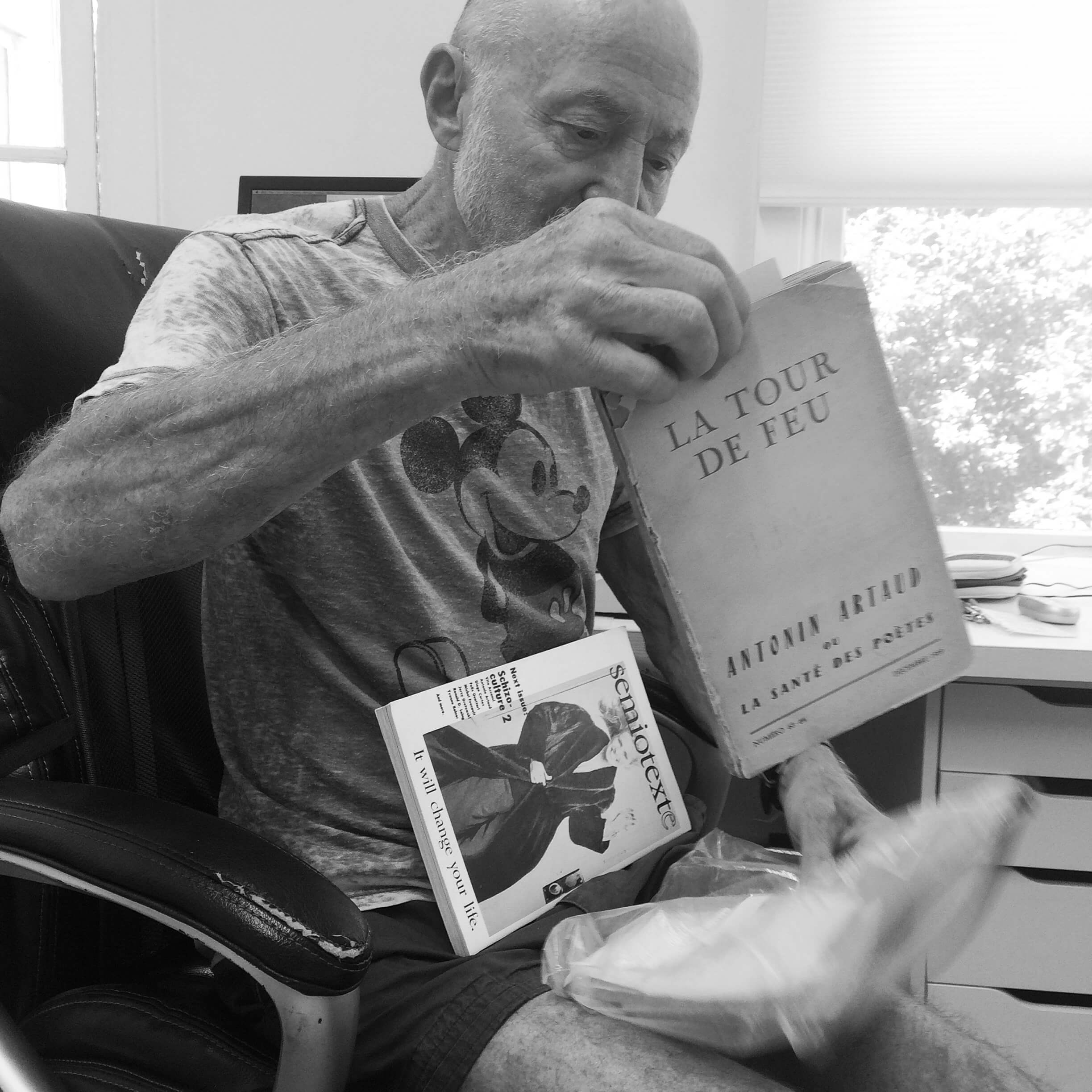
Right, but the first time I talked with Latrémolière I hadn’t read that article because it was a new version of the same issue [La Tour de Feu: Antonin Artaud or la santé des poètes, Décembre 1959]. So he pointed this out and I read it, and I came back the summer after. By then Latrémolière was fit and ready. He really enjoyed our conversation.
He seems much more aggressive with you than Ferdière, when you read the two interviews.
Yes, he lashes at me, but at the same time it was a duel. It was a challenge and he loved debate; it was a debate. So we come and do as best we can to exterminate the other. It was a bit like that. And then there was a follow-up, about me using the interview he made with Artaud’s sister. Ferdière was another thing. I had to realize along the way that he was an intelligent guy. He did a lot for his patients. If he hadn’t bargained and made a black market with the farmers around, no one would have survived there at the time. So I couldn’t condemn him. People want things in black-and-white, and unfortunately, around Artaud, everyone is taking a different position and condemning the others. That’s why I tried to make a book about it, because I’m used to being a perspectivist in relation to philosophy. That’s of course Nietzsche. I thought people were not perspectivist at all in relation to Artaud. They didn’t identity with the situation, they didn’t see the context, they just came up with their feelings and who cares about their feelings? I’m always looking for the document. That’s why I’m a journalist in some way.
What do you mean by document?
I don’t want people’s interpretation. I don’t want people attacking Ferdière just because he gave electroshock. That isn’t enough. You have to go and look into it. The same for Artaud’s mother. Ferdière says the mother never sent any packages. Others say: of course she sent him packages, but Artaud rejected them. See, you never know about these things. You have to have them coexist side-by-side. This and this and this and this. You just try with the bits and pieces and fragments you have to recreate a situation in all its complexity, without a master interpretation. That’s what I try to do with interviews.
He seems much more aggressive with you than Ferdière, when you read the two interviews.
Yes, he lashes at me, but at the same time it was a duel. It was a challenge and he loved debate; it was a debate. So we come and do as best we can to exterminate the other. It was a bit like that. And then there was a follow-up, about me using the interview he made with Artaud’s sister. Ferdière was another thing. I had to realize along the way that he was an intelligent guy. He did a lot for his patients. If he hadn’t bargained and made a black market with the farmers around, no one would have survived there at the time. So I couldn’t condemn him. People want things in black-and-white, and unfortunately, around Artaud, everyone is taking a different position and condemning the others. That’s why I tried to make a book about it, because I’m used to being a perspectivist in relation to philosophy. That’s of course Nietzsche. I thought people were not perspectivist at all in relation to Artaud. They didn’t identity with the situation, they didn’t see the context, they just came up with their feelings and who cares about their feelings? I’m always looking for the document. That’s why I’m a journalist in some way.
What do you mean by document?
I don’t want people’s interpretation. I don’t want people attacking Ferdière just because he gave electroshock. That isn’t enough. You have to go and look into it. The same for Artaud’s mother. Ferdière says the mother never sent any packages. Others say: of course she sent him packages, but Artaud rejected them. See, you never know about these things. You have to have them coexist side-by-side. This and this and this and this. You just try with the bits and pieces and fragments you have to recreate a situation in all its complexity, without a master interpretation. That’s what I try to do with interviews.
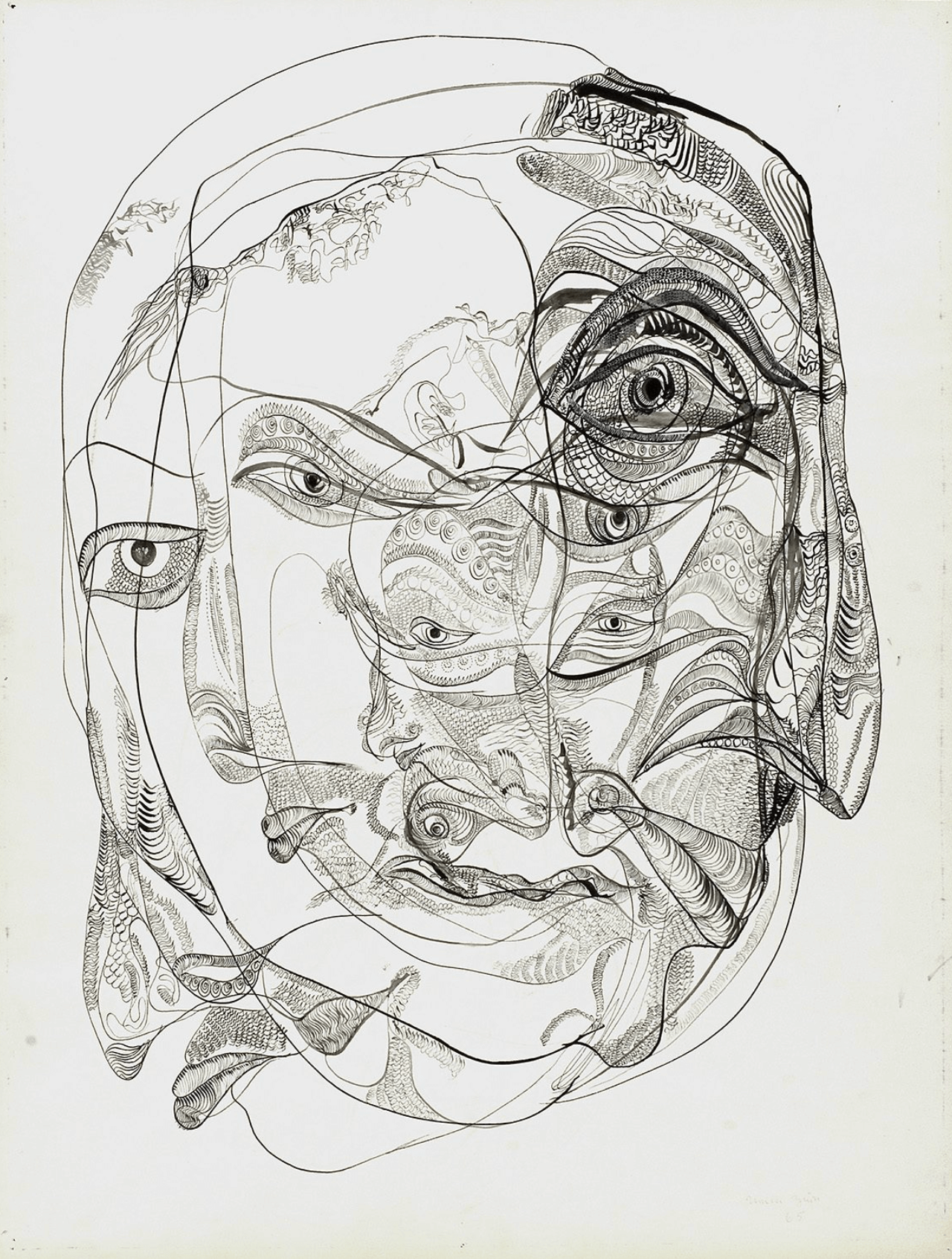


In the 60s, Ferdière treated Unica Zürn and Hans Bellmer, and Isidore Isou says that Ferdière held him against his will for three weeks, precisely during the uprising of May 68.
He wasn’t held, he was helped against his will.
After his release, Isou published Antonin Artaud Tortured by the Psychiatrists. His friend Maurice Lemaître, also a Lettrist, produced a flier titled To Have Done with Reactionary Super-Nazi Psychiatry about Isou’s stay with Ferdière. Then they started a journal, the Review of Psychokladology, which was printed as posters designed to be plastered directly onto the walls of Paris. Issue 3, which read “All Psychiatrists are Demented and Dangerous to themselves and Others,” was plastered directly onto the walls of Sainte-Anne. Isou was waging a war against Ferdière.
He wasn’t held, he was helped against his will.
After his release, Isou published Antonin Artaud Tortured by the Psychiatrists. His friend Maurice Lemaître, also a Lettrist, produced a flier titled To Have Done with Reactionary Super-Nazi Psychiatry about Isou’s stay with Ferdière. Then they started a journal, the Review of Psychokladology, which was printed as posters designed to be plastered directly onto the walls of Paris. Issue 3, which read “All Psychiatrists are Demented and Dangerous to themselves and Others,” was plastered directly onto the walls of Sainte-Anne. Isou was waging a war against Ferdière.
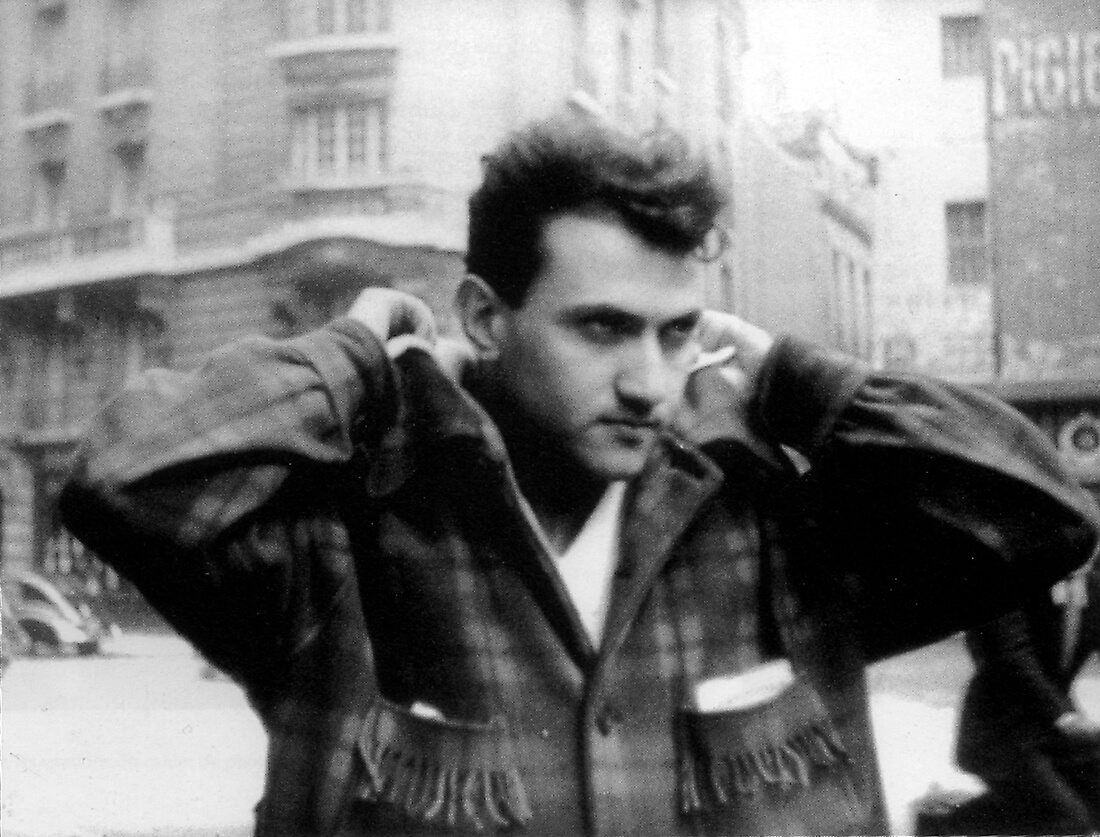
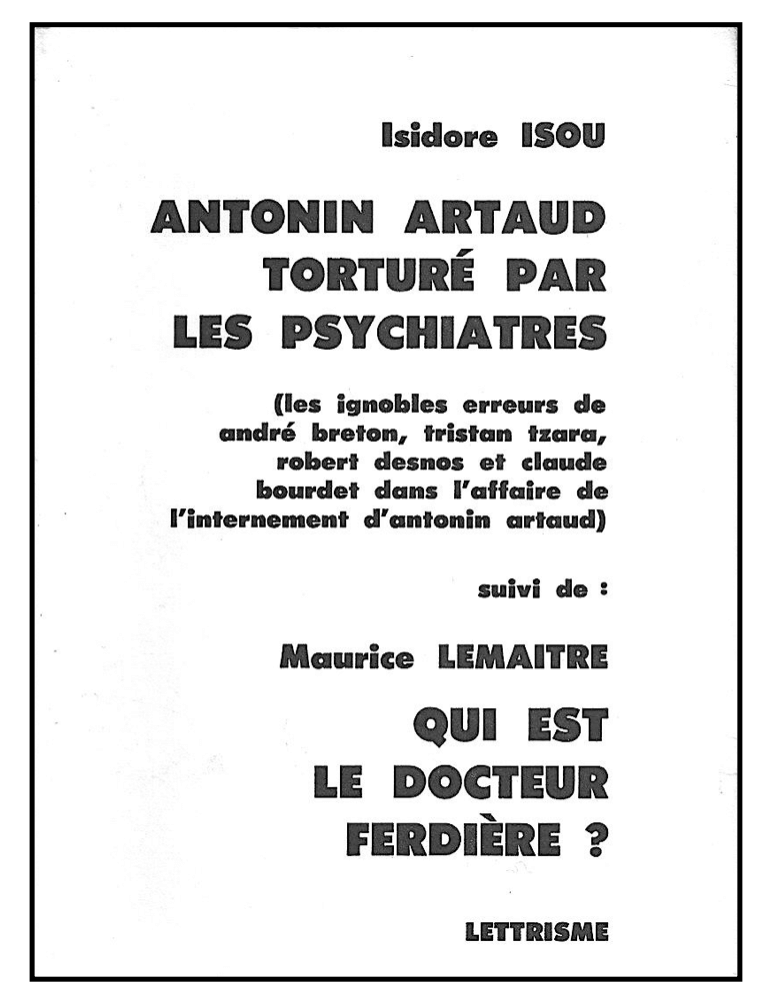
He waged a war against anyone. But he admitted himself that Ferdière saved his life. What can you do? It’s the avant-garde. The avant-garde has to shock, but it doesn’t matter if it’s contradictory. It doesn’t matter as long as you keep the disposition, and Isou didn’t keep the disposition for very long. The Situationists came around and basically reduced the Lettrists as a strange tribe, spelling letters in salons.
Ferdière would put a heated French intellectual in a cooler for a while when they went too far, that’s all. He functioned like that. The only thing I don’t like about Ferdière is his claim on Surrealism. When I asked him for the first time if he knew Artaud, he said, “I knew Artaud.” And I said, “So you talked with him?” And he said, “No, I saw him at a distance.” And that summarized exactly his relation to Artaud and to Surrealism. Desnos was the only one he knew very well.
He claims he went to his house weekly.
Yes but he couldn’t wait to say it ten times, to make sure that it’s right. So he was kind of a grudge. He wanted to be the psychiatrist and the patient, like Gerard de Nerval and his doctor, and Van Gogh and his doctor. He managed to become that.
Or as you say, the Crowned Anarchist.
Yes, yes. So what I saw through that was of course the fact that he was pretty much in control of things, that he was imposing things on Artaud. He had no special empathy for him, and when Artaud bothered him he would just put him back where he belongs. He was basically a head psychiatrist. And he was in charge of a provincial clinic, a psychiatric hospital, away from the action. No one would have talked about him if it were not for Artaud.
You mentioned Eisenstein earlier and I wonder about Artaud’s relation to the Soviets of the 1920s and their theory of shock? Soviet shock theory came out of the theater of attractions and was crucial in the development of montage theory in the mid-20s. In 1928, at the second program of his Alfred Jarry Theater, Artaud presented a screening of Vsevelod Pudovkin’s Mother (1926), which had been banned by the censors. And in “The Theater and Cruelty,” written before Rodez, Artaud says “The endlessly renewed fatigue of the organs requires intense and sudden shocks to revive our understanding.”
It was in the air of the time, as I say: l’air du temps. It circulates from one to the other, and this reinforces my feeling that it’s not really the person that you interrogate. The person, the artist, is the access to the time. And this time was both exciting, because new things were happening, but also very dangerous because people had not begun to realize how much of a horror the First World War really was. It was an extermination of 20 million people. It entirely changed the relation of people to their country, to the earth, to everything. The whole generation we talked about, they were not so prominent, you know, Caillois and this or that. It was just a little group. But they were working on the environment. Artaud, in one of the last letters to Jacques Rivière, says I don’t want you to think that my sickness, that what I feel, is just a symptom of the time. But that was what the time was about, and they were expressing it. And I think that’s why — in the same way the first World War introduced the technology for a bigger massacre — the war never stopped. It was a preparation for the Second World War.
These artists and thinkers were attuned to the degree of atrocity that had been committed, and the fact that society and the population were getting ready for it to continue. All the elements were there but they were the only ones trying to put all of this together. Céline was caught into it; Bataille was attracted to fascism, not because he was a fascist but because, to my mind, he realized that you cannot understand anything if you don’t have at least one foot in it. And that’s what I do with Artaud and Bataille and these people. I can’t really connect to what they went through at the time if I don’t connect with my own unimportant sensibility. What is important is not me or them. They were touching on something that had been touched upon with the First World War, but it was just the beginning.
Ferdière would put a heated French intellectual in a cooler for a while when they went too far, that’s all. He functioned like that. The only thing I don’t like about Ferdière is his claim on Surrealism. When I asked him for the first time if he knew Artaud, he said, “I knew Artaud.” And I said, “So you talked with him?” And he said, “No, I saw him at a distance.” And that summarized exactly his relation to Artaud and to Surrealism. Desnos was the only one he knew very well.
He claims he went to his house weekly.
Yes but he couldn’t wait to say it ten times, to make sure that it’s right. So he was kind of a grudge. He wanted to be the psychiatrist and the patient, like Gerard de Nerval and his doctor, and Van Gogh and his doctor. He managed to become that.
Or as you say, the Crowned Anarchist.
Yes, yes. So what I saw through that was of course the fact that he was pretty much in control of things, that he was imposing things on Artaud. He had no special empathy for him, and when Artaud bothered him he would just put him back where he belongs. He was basically a head psychiatrist. And he was in charge of a provincial clinic, a psychiatric hospital, away from the action. No one would have talked about him if it were not for Artaud.
You mentioned Eisenstein earlier and I wonder about Artaud’s relation to the Soviets of the 1920s and their theory of shock? Soviet shock theory came out of the theater of attractions and was crucial in the development of montage theory in the mid-20s. In 1928, at the second program of his Alfred Jarry Theater, Artaud presented a screening of Vsevelod Pudovkin’s Mother (1926), which had been banned by the censors. And in “The Theater and Cruelty,” written before Rodez, Artaud says “The endlessly renewed fatigue of the organs requires intense and sudden shocks to revive our understanding.”
It was in the air of the time, as I say: l’air du temps. It circulates from one to the other, and this reinforces my feeling that it’s not really the person that you interrogate. The person, the artist, is the access to the time. And this time was both exciting, because new things were happening, but also very dangerous because people had not begun to realize how much of a horror the First World War really was. It was an extermination of 20 million people. It entirely changed the relation of people to their country, to the earth, to everything. The whole generation we talked about, they were not so prominent, you know, Caillois and this or that. It was just a little group. But they were working on the environment. Artaud, in one of the last letters to Jacques Rivière, says I don’t want you to think that my sickness, that what I feel, is just a symptom of the time. But that was what the time was about, and they were expressing it. And I think that’s why — in the same way the first World War introduced the technology for a bigger massacre — the war never stopped. It was a preparation for the Second World War.
These artists and thinkers were attuned to the degree of atrocity that had been committed, and the fact that society and the population were getting ready for it to continue. All the elements were there but they were the only ones trying to put all of this together. Céline was caught into it; Bataille was attracted to fascism, not because he was a fascist but because, to my mind, he realized that you cannot understand anything if you don’t have at least one foot in it. And that’s what I do with Artaud and Bataille and these people. I can’t really connect to what they went through at the time if I don’t connect with my own unimportant sensibility. What is important is not me or them. They were touching on something that had been touched upon with the First World War, but it was just the beginning.

Freud wrote about the death wish at the time, in 1920. Marcel Mauss wrote about the potlatch in 1925. Everyone was getting ready, but they didn’t know it. And some people were getting crazy enough to really go directly against it, or with it, or in it. My relation with all these people was that. Some people were floating with fascism, Bataille a little bit, Simone Weil in some aspect of her work towards the end of her life, when she accused the Jews of being murderers when they were being murdered in Europe. Jews are going to have a hard time acknowledging this, or accepting it, because she did it at the wrong time. But she was crazy. She was crazy for God. But what went on through God was a lot of feeling of despair and self-doubt and a sense of premonition.
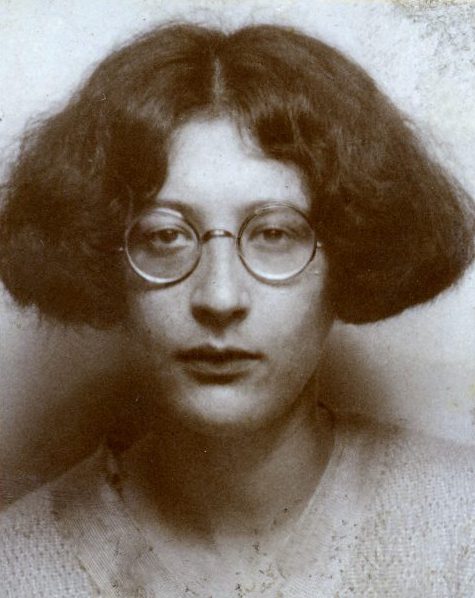
My feeling is that the whole era was a laboratory. Some people participated actively while others were like the cattle that were led into it — the populations in Germany and Italy, with all the affect that was generated. Gustave Le Bon wrote about the crowd, saying that when people are together they become like a group of kids. All this was there, but it’s only retrospectively that historians and sociologists will really start putting things together. They did it at their own expense. They took the risk for it, and one of the risks was madness. I found that more convincing as an approach, maybe as the only approach. That’s why, at times, I felt insufficient, because I connected to something that was so strong that had nothing to do with me, that had everything to do with me, but not with me as a person. I was entering something that I didn’t know how to handle. It was not sacred, because the sacred has a sense of nobility. You acknowledge a person who is about to be killed or victimized. It’s like this ritual you have now among the Islamists, of cutting off people’s heads. Well I find that horrible, but there is a sense that they respect a person that they kill. But the way people were killed during the First and Second World Wars, that had no respect. It was not a sacrifice. It was not a way of solving the problem.
So people were dealing with what they had. They created these groups that were nothing like Tel Quel and that salon group. They were really working on a material that was deadly. You had to match it and you had to know what it is. That’s why they got very close to the point that Walter Benjamin said that Bataille was working for the fascists and all that. I work for the fascists, too, in a sense, because I feel what it could have been like at the time to be totally crazy. But at the same time I can’t express it and I can’t feel that way as a person. For me, that’s the whole attraction. They were there before it happened. Adorno has a famous saying that after Auschwitz you can’t write poetry, but I think this is bullshit. You can write poetry after, but he was right in the sense that, every time I see documents about that time, images of these skeletons that were slumped into trucks — it’s unbearable. That some people could have done that is just beyond the beyond. So I went to people who were emotionally on the same level with what had happened, and that is why.
So people were dealing with what they had. They created these groups that were nothing like Tel Quel and that salon group. They were really working on a material that was deadly. You had to match it and you had to know what it is. That’s why they got very close to the point that Walter Benjamin said that Bataille was working for the fascists and all that. I work for the fascists, too, in a sense, because I feel what it could have been like at the time to be totally crazy. But at the same time I can’t express it and I can’t feel that way as a person. For me, that’s the whole attraction. They were there before it happened. Adorno has a famous saying that after Auschwitz you can’t write poetry, but I think this is bullshit. You can write poetry after, but he was right in the sense that, every time I see documents about that time, images of these skeletons that were slumped into trucks — it’s unbearable. That some people could have done that is just beyond the beyond. So I went to people who were emotionally on the same level with what had happened, and that is why.
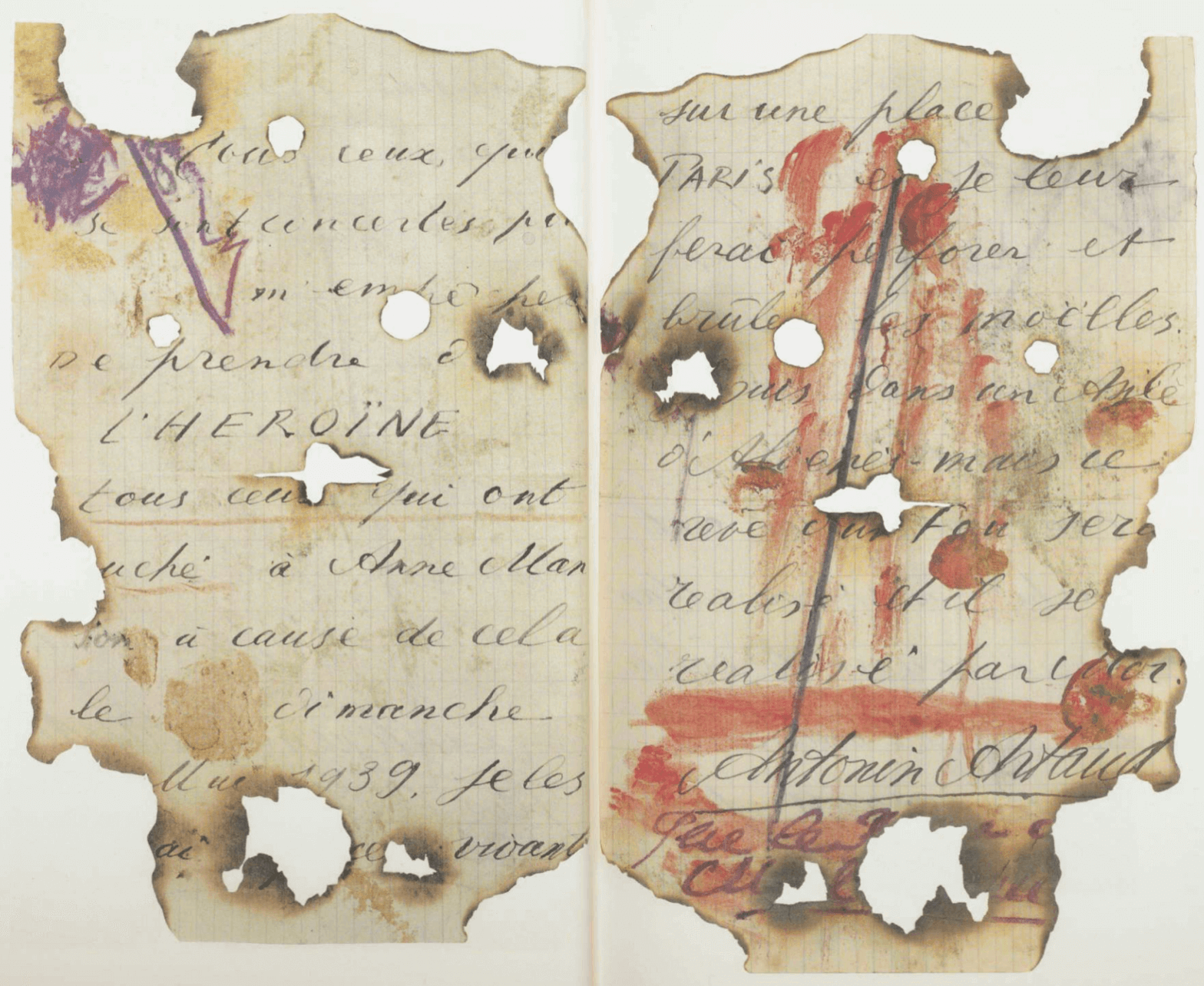
You’re a specialist on Artaud. You taught graduate seminars on Artaud at Columbia University for many years. You have written and lectured about him internationally, you were involved in producing numerous films and videos and performances devoted to Artaud, you performed the role of Artaud on stage, you organized symposia devoted to Artaud, you organized an exhibition, Viandes Mystiques, that traced the influence of Artaud on New York artists of the 1970s and 80s, and you were the consultant for the Museum of Modern Art when Margit Rowell organized an exhibition of Artaud’s Works on Paper, his spells and drawings, around the time of the centenary of his birth in 1996.
Galimard started publishing the Ouvres Completes in 1956, which amounted to 26 volumes that took forty years to publish in total. Here in the US, The Theater and its Double was translated and published by Grove in 1958, twenty years after its original publication. Five years later, City Lights put out an Anthology, and then Sontag edited the Selected Writings for Farrar, Straus and Giroux in 1976. But that only goes through Volume 12 of the 26 volumes in the complete works. There have been a couple other publications, such as The Peyote Dance, also published by Farrar, Straus and Giroux in 1976, which contains writings on the Tarahumaras from the Mexico cycle. But the point is that the majority of his writing is yet to be published in English translation. Given your lifelong commitment to his work, I wonder why you never published any of his writing through your own publishing house, Semiotext(e)?
Because I kept things separate. In the same way there was the academy and there was “the avant-garde.” It just wasn’t the same. I could teach Artaud but this was in the academy. Actually, it’s a series of accidents. When I arrived at Columbia in 1972, the person who used to cover the Dada and Surrealist class had just died. I was there as a specialist of 17th century literature. But I had training in semiotics and anthropology, so I was there both as a 17th century specialist and as a human sciences specialist. That’s what I was supposed to do. But when this colleague died, I just rushed to get this position and to leave the 17th century for somewhere else, so I was free to be contemporaneous.
The thing is, my life was divided. On the one hand, there are those who deal with the problem of capitalism and those who deal with the problem of death. They amount to the same eventually, but it was two different epochs and two different concerns, right?
Capitalism and death belong to two separate epochs?
Yeah, I mean during the 1930s and 40s, death is the main problem, both in its horror and in its fascination. But it’s no wonder, because death had become factory work, right? So people like Lacan, Derrida, the whole French group, they are people who somehow are addressing the immediate concerns of society. The problem of subjectivity, the problem of groups, the problem of a society that is quickly changing and becoming abstracted — which is another connection with Artaud. Artaud says culture has no connection with reality any more. And that’s exactly the kind of situation we inherited in the 70s, not in New York, but in the world. Suddenly the whole world became a semiosphere. The whole world works with signs; consumerism is a sign system.
But wouldn’t that have started in the 20s?
Yes, but everyone felt that there was a rupture. Now everything was being reproduced. Not produced, but reproduced. The media took over; the sign took over. Everything was a representation of the thing and not the thing itself. That’s why it’s no wonder that the French rediscovered Saussure at the time, and Roland Barthes started working upon it. We were entering a society of the sign. But sign means that you are divorced from reality, from the reference. Saussure devised a sign system but he excluded the reality as something that doesn’t belong to the sign.
So in 1974 you started the journal Semiotext(e) as an intervention into the study of sign systems, to put an emphasis on materialist semiotics?
Galimard started publishing the Ouvres Completes in 1956, which amounted to 26 volumes that took forty years to publish in total. Here in the US, The Theater and its Double was translated and published by Grove in 1958, twenty years after its original publication. Five years later, City Lights put out an Anthology, and then Sontag edited the Selected Writings for Farrar, Straus and Giroux in 1976. But that only goes through Volume 12 of the 26 volumes in the complete works. There have been a couple other publications, such as The Peyote Dance, also published by Farrar, Straus and Giroux in 1976, which contains writings on the Tarahumaras from the Mexico cycle. But the point is that the majority of his writing is yet to be published in English translation. Given your lifelong commitment to his work, I wonder why you never published any of his writing through your own publishing house, Semiotext(e)?
Because I kept things separate. In the same way there was the academy and there was “the avant-garde.” It just wasn’t the same. I could teach Artaud but this was in the academy. Actually, it’s a series of accidents. When I arrived at Columbia in 1972, the person who used to cover the Dada and Surrealist class had just died. I was there as a specialist of 17th century literature. But I had training in semiotics and anthropology, so I was there both as a 17th century specialist and as a human sciences specialist. That’s what I was supposed to do. But when this colleague died, I just rushed to get this position and to leave the 17th century for somewhere else, so I was free to be contemporaneous.
The thing is, my life was divided. On the one hand, there are those who deal with the problem of capitalism and those who deal with the problem of death. They amount to the same eventually, but it was two different epochs and two different concerns, right?
Capitalism and death belong to two separate epochs?
Yeah, I mean during the 1930s and 40s, death is the main problem, both in its horror and in its fascination. But it’s no wonder, because death had become factory work, right? So people like Lacan, Derrida, the whole French group, they are people who somehow are addressing the immediate concerns of society. The problem of subjectivity, the problem of groups, the problem of a society that is quickly changing and becoming abstracted — which is another connection with Artaud. Artaud says culture has no connection with reality any more. And that’s exactly the kind of situation we inherited in the 70s, not in New York, but in the world. Suddenly the whole world became a semiosphere. The whole world works with signs; consumerism is a sign system.
But wouldn’t that have started in the 20s?
Yes, but everyone felt that there was a rupture. Now everything was being reproduced. Not produced, but reproduced. The media took over; the sign took over. Everything was a representation of the thing and not the thing itself. That’s why it’s no wonder that the French rediscovered Saussure at the time, and Roland Barthes started working upon it. We were entering a society of the sign. But sign means that you are divorced from reality, from the reference. Saussure devised a sign system but he excluded the reality as something that doesn’t belong to the sign.
So in 1974 you started the journal Semiotext(e) as an intervention into the study of sign systems, to put an emphasis on materialist semiotics?
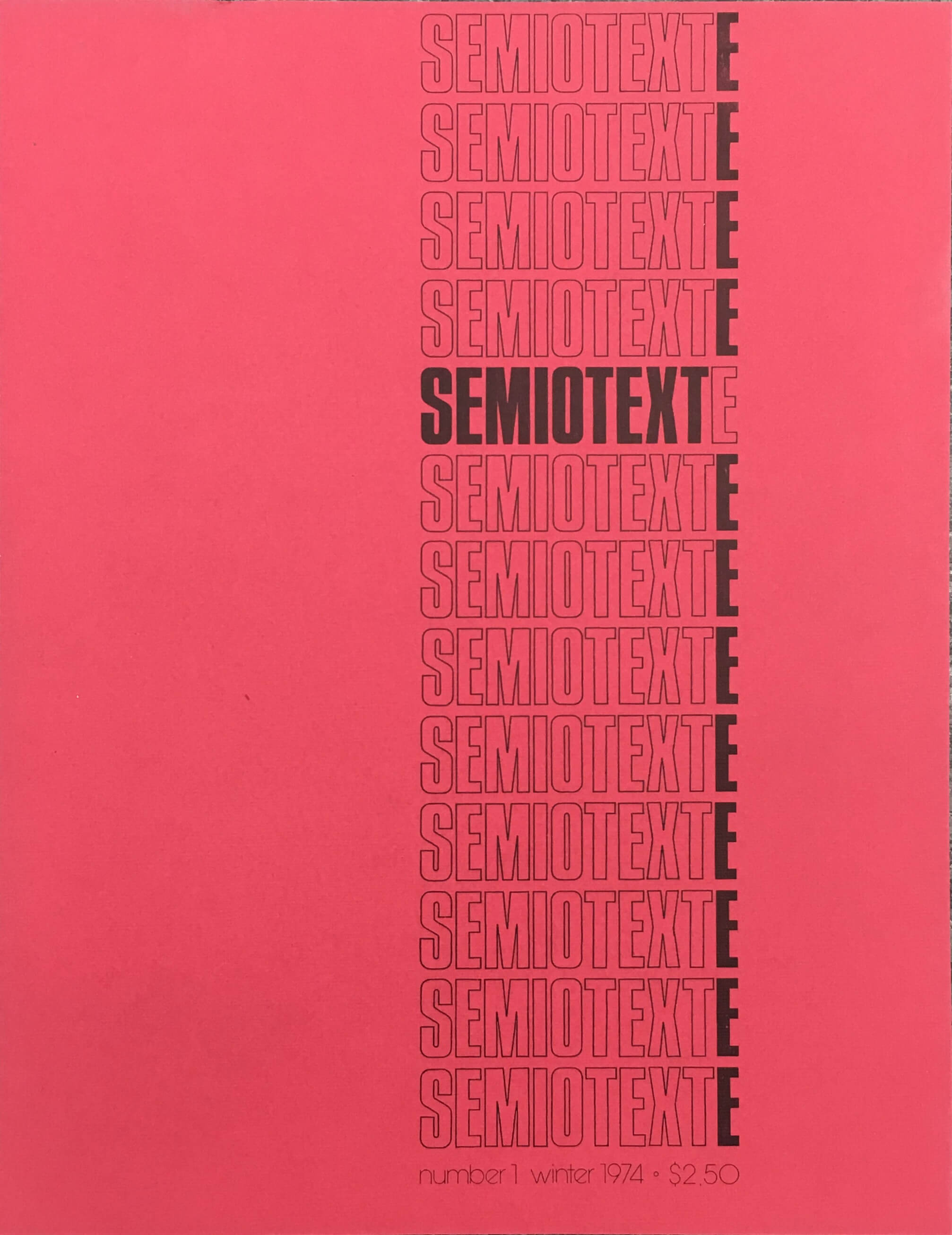
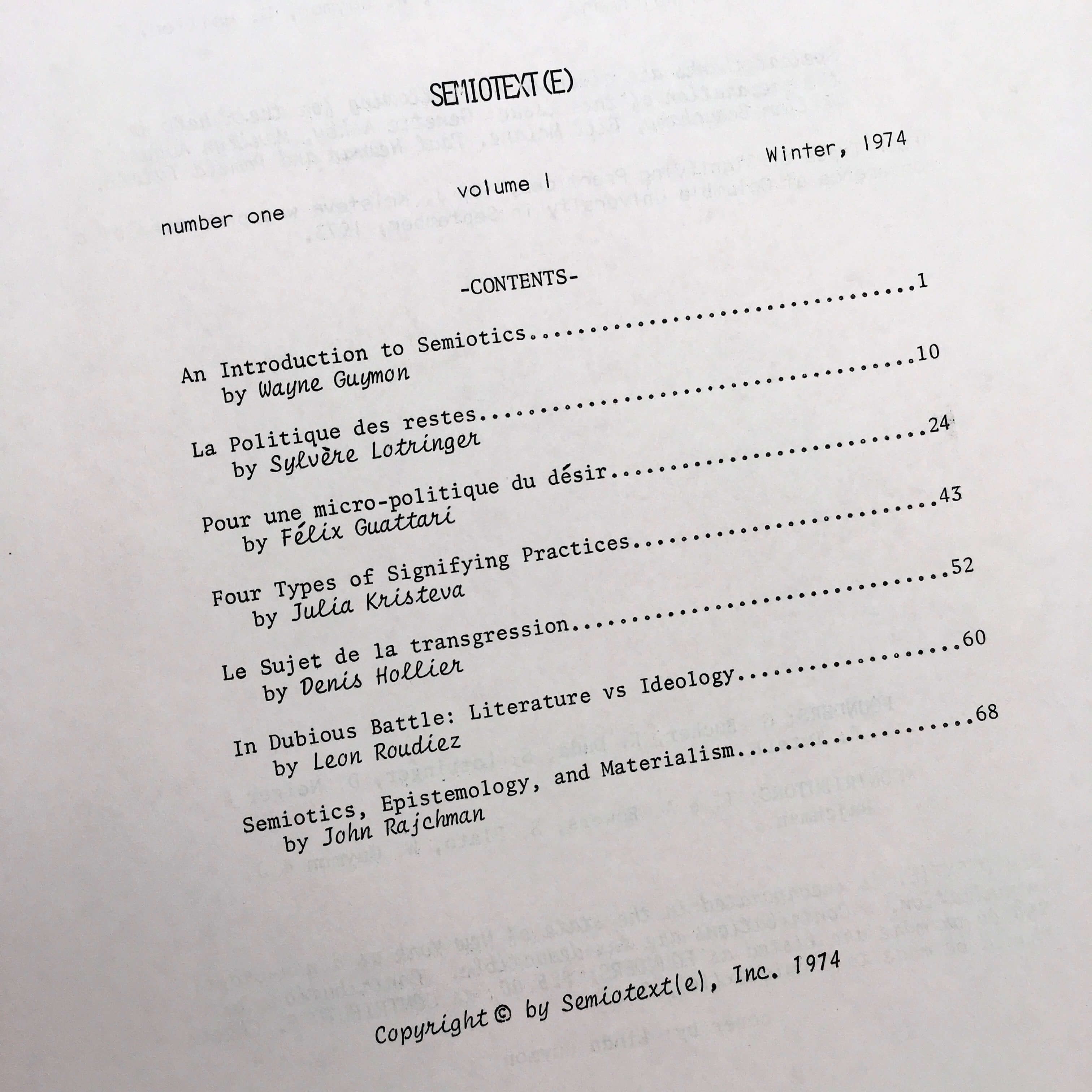
Well we felt that semiotics was an important science, but it was limited by the fact that it relied on linguistics as a model. Everything had to be re-presented by language before it reached dance, or colors, or anything else. Semiotics is everywhere. Why was it that language became the model? So we were looking for someone like Yuri Lotman, who was at Tartu University in Russia, where they said that the word “table” designates a table, but a table can designate the word. What it means is that you are in a psychotic universe. Now we’re in a universe of signs. Signs refer to other signs, they don’t refer to reality any more.
That was the difference between these two periods we’re discussing, the 1930s and 40s, and the 1970s, 80s, and 90s. They were using religious concepts in that earlier period in order to analyze society, which is why they had to go through rituals and sacrifice and death. For people who came later, at the time of May 68 and the consumer society which had invaded France, there was no God any more. The sign had replaced everything. Images were replacing everything. The society of the spectacle was taking over. So you had to envisage that as something very different, where affects were not vital, but viral. The sign connected signs to other signs. It was like the plague — the plague was a system that connected everything — so it was very different, historically.
And then there’s the society we live in today where everything is being abstracted by technology. Technology is engulfing the entire society and destroying the environment. We’re not in control anymore. The corporations are much more decisive than nations and presidents and there’s no one to stop them. They are on the way to the next massacre, the massacre of the environment, by creating a world that is basically unlivable. It’s part of the same continuation.
That was the difference between these two periods we’re discussing, the 1930s and 40s, and the 1970s, 80s, and 90s. They were using religious concepts in that earlier period in order to analyze society, which is why they had to go through rituals and sacrifice and death. For people who came later, at the time of May 68 and the consumer society which had invaded France, there was no God any more. The sign had replaced everything. Images were replacing everything. The society of the spectacle was taking over. So you had to envisage that as something very different, where affects were not vital, but viral. The sign connected signs to other signs. It was like the plague — the plague was a system that connected everything — so it was very different, historically.
And then there’s the society we live in today where everything is being abstracted by technology. Technology is engulfing the entire society and destroying the environment. We’re not in control anymore. The corporations are much more decisive than nations and presidents and there’s no one to stop them. They are on the way to the next massacre, the massacre of the environment, by creating a world that is basically unlivable. It’s part of the same continuation.
Previous:
Next:
Next:
